5 aboard Titanic tourist sub are dead after ‘catastrophic implosion’
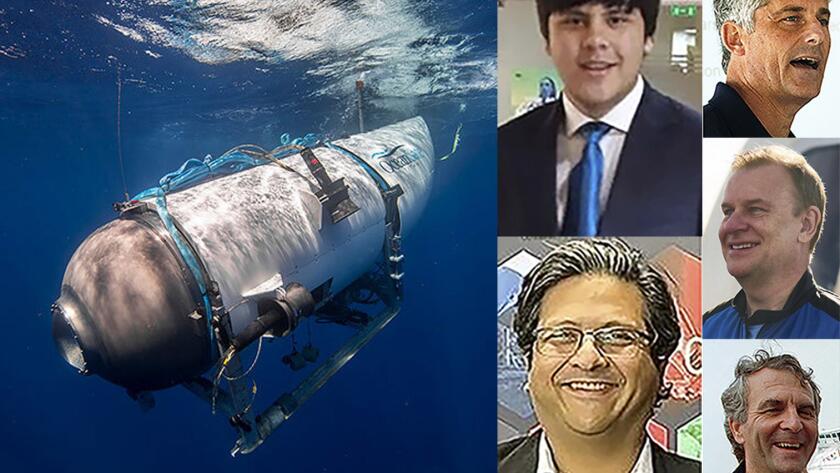
The five passengers on a sub that vanished on a trip to explore the Titanic wreckage have died after a catastrophic implosion, U.S. Coast Guard says.
- Show more sharing options
- Copy Link URL Copied!
All five passengers aboard a submersible that vanished while on a dive to explore the Titanic wreck site have died, officials said Thursday after underwater robots discovered seafloor debris from the sub that was “consistent with a catastrophic implosion.”
A robot from the Canadian vessel Horizon Arctic discovered several major pieces of the 21-foot sub, the Titan , in a debris field about 1,600 feet from the bow of the Titanic, U.S. Coast Guard Rear Adm. John W. Mauger said at a news conference.
“The debris is consistent with the catastrophic loss of the pressure chamber,” Mauger said.
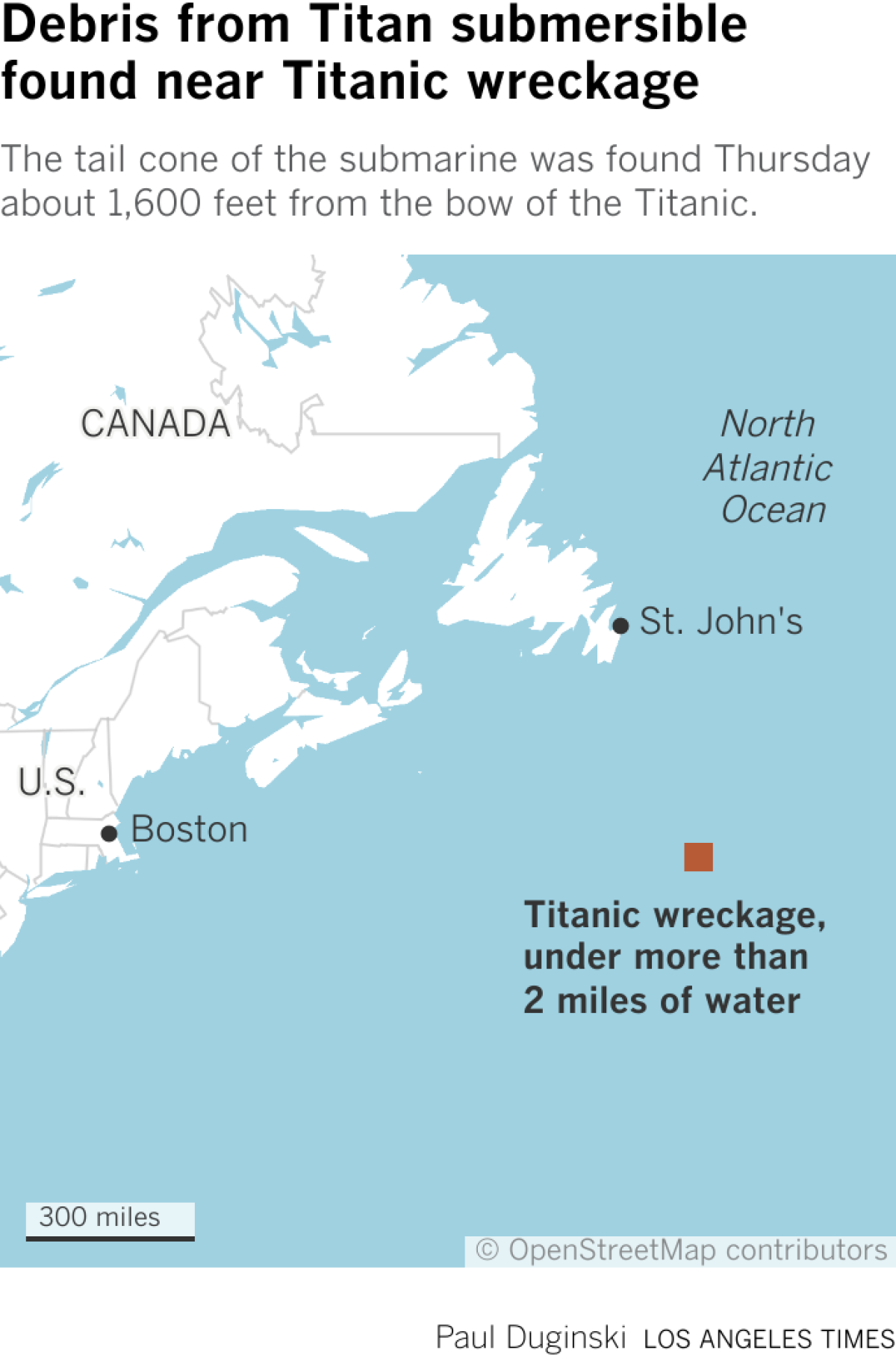
The families of the passengers have been notified, he said.
“On behalf of the U.S. Coast Guard and the entire unified command, I offer my deepest condolences to the families,” he said. “I can only imagine what this has been like for them. I hope that this discovery provides some solace during this difficult time.”
The five passengers were Stockton Rush, the pilot of the exploration and chief executive of OceanGate Expeditions, which owns and operates the sub; Hamish Harding , chairman of Action Aviation, a Dubai-based aircraft dealer; Paul-Henry Nargeolet, a veteran and accomplished diver with more than 30 trips to the wreck site; and Pakistani businessman Shahzada Dawood and son Suleman.

OceanGate said in a statement that its “hearts are with these five souls and every member of their families during this tragic time.”
“These men were true explorers who shared a distinct spirit of adventure and a deep passion for exploring and protecting the world’s ocean,” the company said. “We grieve the loss of life and joy they brought to everyone they knew.”

World & Nation

‘Catastrophic’ safety concerns raised about sub long before ill-fated Titanic voyage
Long before a submersible vanished on an expedition to explore the wreck of the Titanic, concerns were raised about the safety of the vessel.
June 21, 2023
The sub was reported missing after it lost contact with the Canadian research vessel Polar Prince about 1 hour and 45 minutes into its dive Sunday about 900 miles east of Cape Cod, Mass., the Coast Guard said.
Its disappearance set off an international search-and-rescue effort , as crews raced around the clock using specialized equipment to find the sub, which was designed to have an initial air supply of 96 hours. Officials also said it had only “limited rations” of food and water.
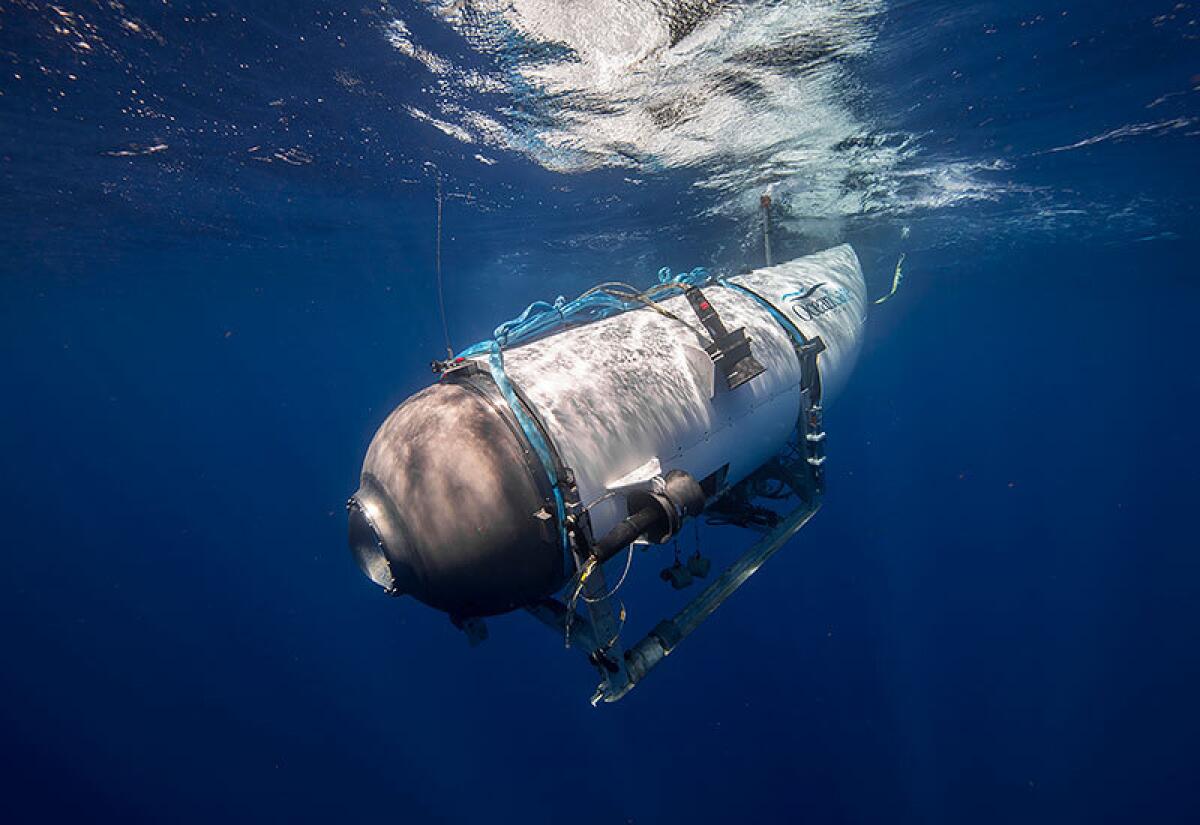
The search grew to 10,000 square miles, roughly the size of Massachusetts, and went 2½ miles deep. Through the days-long effort, officials maintained optimism that the operation would remain a search-and-rescue effort and not a recovery mission.
Assets launched in the search included American and Canadian aerial support vessels that scanned the ocean’s surface and subsurface using sonobuoys; U.S. Navy divers; coast guard and research vessels from Canada, France and Norway, some of which were equipped with highly specialized remote-operated vehicles that could work on the ocean’s floor; and assistance from commercial vessels.
A moment of promise came Tuesday when the Coast Guard confirmed reports that banging noises were detected on the seafloor by sonobuoys dropped from Canadian aircraft. Although officials said the origins of the sounds were unclear, they became the target of search efforts.
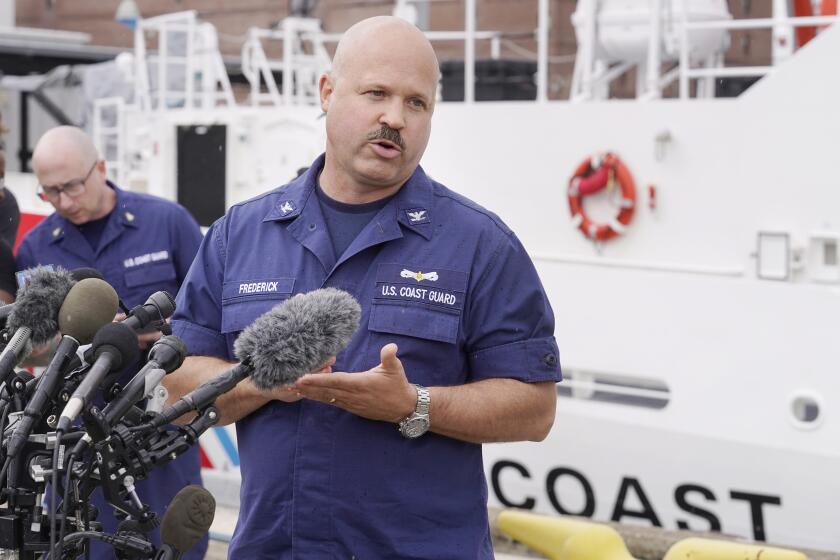
Sounds described as ‘rhythmic tapping’ on hull heard in search for Titanic tourist sub
The use of remotely operated vehicles in the search for the Titanic tourist submersible carrying five people has yielded no results, the U.S. Coast Guard said.
At the news conference Thursday, Mauger said the underwater noises , which were also observed Wednesday, did not appear to be connected to the sub’s location. The implosion would generate “significant broadband sound” that would have been picked up by the sonobuoys, he said.
Paul Hankins, a salvage expert for the U.S. Navy, said five major pieces of debris from the Titan were found, including the nose cone, which was outside of the pressure hull. Crews also found a large debris field that contained the front-end bell of the pressure hull.
“That was the first indication there was a catastrophic event,” he said. A second, smaller debris field contained the other end of the pressure hull and other wreckage that compromised the totality of the vessel.
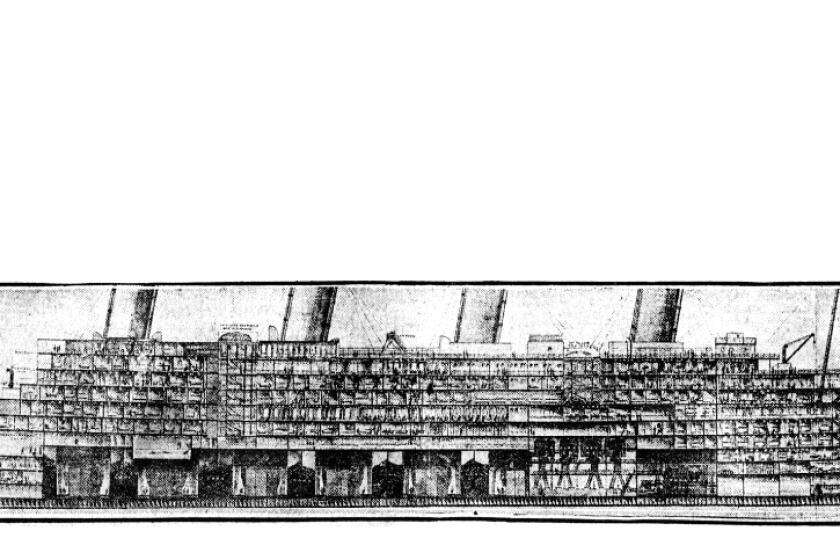
How The Times covered the sinking of the Titanic: ‘The annihilated Leviathan’
June 22, 2023
Officials said that the debris was in an area away from the Titanic wreckage in a patch of smooth ocean floor and that there were no signs the vessel collided with the historic ship. The size of the debris field and the vessel’s last-known location are consistent with an “implosion in the water column,” officials said.
Mauger said it is too early to tell when the vessel imploded, and added that listening equipment used throughout the search did not detect any type of catastrophic event.
However, a U.S. government official familiar with the incident but not authorized to speak to the media told The Times that technology designed to listen to the ocean for movement captured the sound of the submersible imploding around the time communications were lost. The news was first reported by the Wall Street Journal, which noted the sound “anomaly.”
When asked whether the victims’ remains might be recovered, Mauger said he did not have an answer, reiterating the implosion and underlining the ocean’s harsh conditions. “This is an incredibly unforgiving environment down there on the seafloor,” he said.
Like the search-and-rescue efforts, the investigation into what happened will be complex, Mauger said, because of the remote location where the event occurred and because it involves the government agencies of several countries whose citizens were aboard.
The composite material used to build the sub and a lack of safety systems will be the focus of a maritime inquiry, which most likely will involve Canadian and U.S. investigators, according to sources familiar with such operations.
Nine vessels were at the location Thursday, and demobilization efforts are expected to take place over the next 24 hours. But remote-operated vehicles will continue to map the ocean floor, Mauger said, and officials are working to develop a timeline of the implosion.
“I know that there’s also a lot of questions about how, why and when did this happen,” Mauger said. “Those are questions that we will collect as much information as we can on now.”
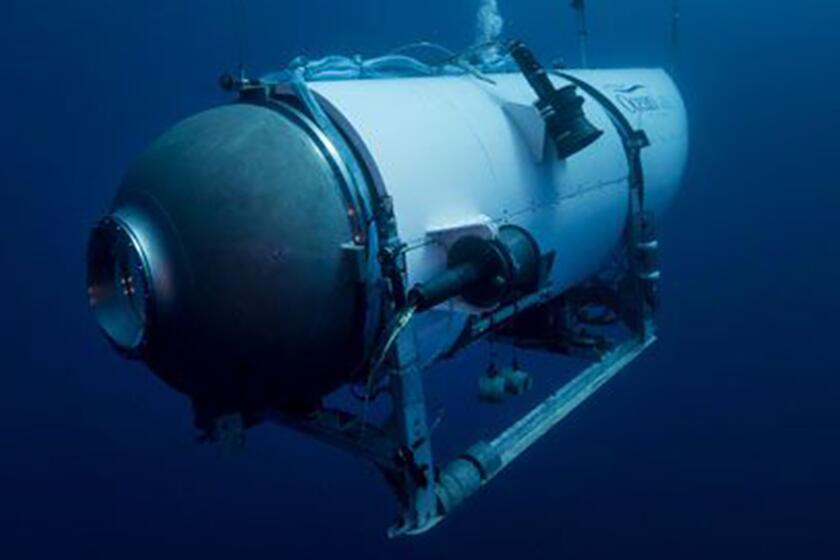
Entertainment & Arts
Commentary: As those aboard the Titan submersible suffered, social media laughed
The exploitative coverage of the death and terror unfolding in real time as the search for the Titan sub continued was compounded by the public’s reaction on TikTok and Twitter.
OceanGate has been running expeditions with “citizen explorers” to the Titanic since 2021 on its Titan sub, according to its website. But as the search unfolded, new details emerged that submersible industry leaders, oceanographers and former employees had long sent warning signs about the Titan.
The Manned Underwater Vehicles Committee at the Marine Technology Society, which advocates for marine technology and resources, wrote a private letter to Rush in 2018 calling on him to allow for a third-party safety review of the Titan. The letter said the marketing for the Titan was, “at minimum, misleading to the public and breaches an industry-wide professional code of conduct we all endeavor to uphold.”
“Our apprehension is that the current experimental approach adopted by OceanGate could result in negative outcomes (from minor to catastrophic) that would have serious consequences for everyone in the industry,” the letter stated.
That same year, David Lochridge, a former OceanGate employee, raised red flags about the Titan in litigation against the company, “particularly OceanGate’s refusal to conduct critical, non-destructive testing of the experimental design of the hull.”
Lochridge, a submersible pilot hired to do quality and safety inspections, said he was terminated for coming forward. He said he disagreed with Rush’s decision to “subject passengers to potential extreme danger in an experimental submersible.” In court papers, OceanGate denied Lochridge’s claims, and the case was later settled.
Rush had criticized what he considered red tape. “One of the jabs that gets thrown at us is: ‘Hey, you aren’t certified.’ But how can you do something new and get certified?” Rush asked in a 2022 article in Maptia. “If the rules exist for how to do it, then you are operating outside of the rules by doing something different.”
Referring to Gen. Douglas MacArthur, he added: “I think it was MacArthur who said, ‘You are remembered for the rules you break.’ We try to break the rules intelligently and intentionally.”
Times staff writers Richard Winton and Noah Goldberg in Los Angeles contributed to this report.
More to Read

Body of fifth missing worker found more than a month after Baltimore bridge collapse
May 2, 2024

Divers discover wreckage and remains from U.S. Air Force crash off Japan
Dec. 4, 2023

5-year-old dies after she and a man are swept out to sea at Half Moon Bay. ‘Sneaker waves’ cited
Nov. 26, 2023
Start your day right
Sign up for Essential California for news, features and recommendations from the L.A. Times and beyond in your inbox six days a week.
You may occasionally receive promotional content from the Los Angeles Times.

Alexandra E. Petri is a former Los Angeles Times staff writer who covered trends and breaking news. She previously covered live news at the New York Times. A two-time reporting fellow with the International Women’s Media Foundation, she graduated from Penn State with a degree in journalism and international studies.
More From the Los Angeles Times

Progress reported in Gaza truce talks, but Israel downplays chances of ending war with Hamas

Hulk Hogan, hurricanes and a blockbuster recording: A week in review of Trump’s hush money trial

Drone footage shows Ukrainian village battered to ruins as residents flee Russian advance

U.N. official warns that famine in northern Gaza is already ‘full-blown’
'True explorers': The 5 passengers who died on the missing Titanic submersible

Five men, including one teenager, have been declared dead days after they left for a voyage in a 22-foot submersible to see the wreckage of the Titanic in the North Atlantic Ocean.
OceanGate, the company that hosted the mission on the Titan submersible to the Titanic, said Thursday that the entire crew – including its founder and CEO who was the pilot in the mission – were “lost at sea.” The U.S. Coast Guard also announced Thursday that rescue teams had found debris from the ship on the ocean floor “consistent with catastrophic loss of the pressure chamber.”
The passengers were well known for their devotion to extreme exploration, desire to collect artifacts from the Titanic or their exorbitant wealth. Each paid $250,000 to ride on the submersible. The Coast Guard said families of the men had been notified of their deaths.
"These men were true explorers who shared a distinct spirit of adventure, and a deep passion for exploring and protecting the world’s oceans. Our hearts are with these five souls and every member of their families during this tragic time," OceanGate said in a statement Thursday.
Rear Admiral John Mauger of the U.S. Coast Guard said during a press conference Thursday he did not know whether the Coast Guard would be able to recover the bodies.
"This is an incredibly unforgiving environment down there on the seafloor," he said.
For live updates on this disaster, read USA TODAY’s live blog here . The passengers on the sub were:
OceanGate's CEO Stockton Rush
Stockton Rush, 61, founded OceanGate in 2009. He was also the co-founder of OceanGate Foundation , a non-profit organization "which aims to catalyze emerging marine technology to further discoveries in marine science, history, and archaeology," according to the company's website.
Rush said at a conference in Seattle last year: “One of the reasons I started the business was because I didn’t understand why we were spending 1,000 times as much money to explore space as we were to explore … the oceans. There is no private access to the deep ocean, and yet there’s all this life to be discovered.”
At the same conference, he also said submarine safety programs were “over the top in their rules and regulations.”
Before graduating from Princeton University with a degree in aerospace engineering in 1984 and obtaining a master’s degree in business administration from the University of California in 1989, Rush had obtained his captain’s rating at the United Airlines Jet Training Institute. He went on to oversee business ventures that included serving on the board of Seattle’s BlueView Technologies and as chairman of Remote Control Technology.
Greg Stone, the former executive vice president and chief scientist for Conservation International as well as a friend of Rush, said there was a need for advances in research submersibles.
“That’s the direction he was going in. And I liked where he was going,” Stone said.
But, he added, Rush “had the problem that a lot of frontier people have. And that is he was ahead of the regulations.”
Rush had familial ties to the Titanic, NPR reported . Stockton Rush was married to Wendy Rush, the great-great granddaughter of Isador and Ida Straus, who were on board the sinking Titanic ship together.
British billionaire explorer Hamish Harding
Hamish Harding, 58, was chairman of Action Aviation, a global sales company in business aviation. He held three Guinness World Records related to his explorations by plane and into the deep ocean. He had also been to space.
He had been looking forward to his Titan ride. “Due to the worst winter in Newfoundland in 40 years, this mission is likely to be the first and only manned mission to the Titanic in 2023," Harding wrote in a Facebook post Saturday, the day before the Titan voyage, according to the New York Times. "A weather window has just opened up and we are going to attempt a dive tomorrow. We started steaming from St. Johns, Newfoundland, Canada yesterday and are planning to start dive operations around 4am tomorrow morning. Until then we have a lot of preparations and briefings to do."
Richard Garriott de Cayoux, president of The Explorers Club, mourned the loss of his friends Harding and Paul-Henry Nargeolet on Twitter in a letter Thursday to “fellow explorers.”
“They were both drawn to explore, like so many of us, and did so in the name of meaningful science for the betterment of mankind,” he wrote. “Their memories will be a blessing and will continue to inspire us in the name of exploration.”
French maritime and Titanic expert Paul-Henri Nargeolet
Paul Henri-Nargeolet, 73, was director of Underwater Research for E/M Group and RMS Titanic, Inc. He successfully dived in a submersible to the site of the Titanic wreckage 37 times and "supervised the recovery of 5,000 artifacts," according to EMGroup's website , which also says he's "widely considered the leading authority on the wreck site."
"Born in Chamonix, France, P.H. lived in Africa for 13 years with his family and at 16 returned to France to complete his studies in Paris. He later joined the French Navy for a career that spanned 22 years and saw him rise in the ranks to Commander," according to the company site.
“I really hope they will find them all safe,” his daughter Sidonie Nargeolet said prior to Thursday’s announcement.
Dive expert David Mearns called Harding “a terrific character," and said Nargeolet was “almost a legend really in the field of deep sea exploration,” BBC reported.
Shahzada Dawood
Shahzada Dawood, 48, was one of the richest men in Pakistan and served as vice chairman of Pakistani Engro Corporation , a Pakistani conglomerate founded as a fertilizer company, where he worked for 20 years. He was on the board of trustees for the Dawood Foundation, an education nonprofit, and on the board of the SETI Institute, a non-profit research organization.
Dawood had over two decades of experience “in corporate governance” and “ the transformation of industries, including growth and innovation opportunities through mergers and acquisitions of diversified public-listed companies across textiles, fertilizers, foods, and energy,” his profile on the World Economic Forum site reads.
"He aspires to a sustainable future and believes in inclusive business models involving low-income communities building value chains along business interests," the profile states .
He is survived by his wife, Christine Dawood, and his daughter, Alia Dawood.
Suleman Dawood
Suleman Dawood, 19, loved science fiction, solving Rubik’s Cubes and playing volleyball, the New York Times reported . He was studying at the University of Strathclyde in Glasgow, according to the BBC.
Shahzada Dawood's older sister told NBC News she was "absolutely heartbroken" over the deaths.
"I feel like I’ve been caught in a really bad film, with a countdown, but you didn’t know what you’re counting down to," Azmeh Dawood said. "I personally have found it kind of difficult to breathe thinking of them."
She also said her nephew Suleman told one of their relatives that he was “terrified” about the voyage. She told NBC News Suleman went on the trip with his dad because he wanted to make his dad happy and it fell on the Father's Day weekend.
“I am thinking of Suleman, who is 19, in there, just perhaps gasping for breath… It’s been crippling, to be honest,” she told the news outlet.
In a letter to the “friends, followers and community of the SETI Institute” Thursday, CEO Bill Diamond shared the news of the deaths of Dawood and his son.
“Shahzada was passionately curious and an enthusiastic supporter of the SETI Institute and our mission, being directly involved in philanthropic programs in education, research and public outreach,” said Diamond. “He will be deeply missed by all who knew him, especially his fellow Trustees and the leadership of the SETI Institute.”
The Associated Press contributed to this report.
- Skip to main content
- Keyboard shortcuts for audio player
What we know about the 5 men who were aboard the wrecked Titan sub
Ayana Archie

The five men who were aboard the Titan were declared dead on Thursday after search and rescue crews found evidence the submersible had imploded. Bill Sikes/AP; Victoria Sirakova/Getty Images; Joel Saget/AFP via Getty Images; Engro Corporation Limited via Reuters hide caption
The five men who were aboard the Titan were declared dead on Thursday after search and rescue crews found evidence the submersible had imploded.
The five people who have been missing since going on a deep sea dive destined for the Titanic shipwreck are believe to have died , officials said Thursday.
"These men were true explorers who shared a distinct spirit of adventure, and a deep passion for exploring and protecting the world's oceans," OceanGate, the company that developed the submersible, said in a statement. "Our hearts are with these five souls and every member of their families during this tragic time."
The passengers included British businessman Hamish Harding, Pakistani investor Shahzada Dawood and his son Suleman, French diver Paul-Henri Nargeolet and OceanGate CEO Stockton Rush.
Here's what we know about them.
Hamish Harding

British businessman Hamish Harding, pictured here in Beverly Hills, Calif., in January, was the holder of three Guinness World Records. Victoria Sirakova/Getty Images hide caption
British businessman Hamish Harding, pictured here in Beverly Hills, Calif., in January, was the holder of three Guinness World Records.
Harding was the chairman of Action Aviation, an aviation sales and consulting company.
Retired NASA astronaut Terry Virts told NPR his friend Harding "is an explorer by nature."
Harding broke the Guinness world record for the fastest flight around both the Earth's poles in 2019, in which Virts was a crew member. Harding has additionally broken Guinness world records for the longest duration at a full ocean depth by a crewed vessel and the longest distance traveled along the deepest part of the ocean.
Shahzada Dawood
Dawood was the vice chairman of Engro, a Pakistani energy investment company, and the Dawood Hercules Corp., an investment and holdings firm. He had expertise in mergers and acquisitions in companies across industries, such as textiles, fertilizers, foods and energy.

All 5 passengers aboard Titan sub are believed dead after 'catastrophic implosion'
Additionally, he served on various boards, including the SETI Institute, a NASA-funded nonprofit dedicated to extraterrestrial research, and Prince Charles' charity, Prince's Trust International.
Dawood obtained an undergraduate law degree from Buckingham University in the U.K. and a master's of science in global textile marketing from Philadelphia University (now known as Thomas Jefferson University).
He is survived by his wife, Christine, and his daughter, Alina.
Suleman Dawood
The 19-year-old Suleman, a college student, was the son of Shahzada Dawood.
He had recently completed his first year as a business major at the University of Strathclyde in Glasgow, Scotland.
Stockton Rush

OceanGate CEO and co-founder Stockton Rush speaks near Nantucket, Mass., on June 13, 2016. Bill Sikes/AP hide caption
OceanGate CEO and co-founder Stockton Rush speaks near Nantucket, Mass., on June 13, 2016.
Rush, a British businessman, founded OceanGate in 2009 and served as the organization's CEO, overseeing the development of submersibles that would be able to travel up to 20,000 feet below the ocean's surface.
"Taking an early lead in an emerging market, Stockton recognized that private industry funding and utilization of modern materials could have a major impact on our ability to explore the deep oceans while significantly lowering the cost of discovery," the OceanGate website says.

The wife of OceanGate's CEO is descended from a famous couple who died on the Titanic
In 1981, Rush became the youngest jet transport rated pilot in the world at the time at 19, flying to destinations, such as Cairo, Mumbai and Zurich, according to his biography.
He received a bachelor's degree in aerospace engineering from Princeton University and a business master's degree from UC Berkeley. In 1989, he developed his own experimental aircraft, which he had flown before.
He additionally served on boards and development teams for companies making sonar systems, software and remote controls, as well as at The Museum of Flight in Seattle.
Paul-Henri Nargeolet

Paul-Henri Nargeolet, pictured at a Paris expo in May 2013, was considered a leading Titanic expert. Joel Saget/AFP via Getty Images hide caption
Paul-Henri Nargeolet, pictured at a Paris expo in May 2013, was considered a leading Titanic expert.
Nargeolet, known as "Mr. Titanic" for his expertise of the ship, spent 22 years in the French navy, where he was eventually ranked commander. He retired from the navy in 1986 and oversaw two deep sea submersibles at the French Institute for Research and Exploitation of the Sea. While there, he led the first recovery dive to the Titanic wreckage in 1987, according to his biography.
He was the director of underwater research for RMS Titanic Inc., a company dedicated to preserving the history of the Titanic, and the E/M Group, a company that provides exhibitions and other entertainment.

The missing submersible raises troubling questions for the adventure tourism industry
He completed 37 dives in a submersible to the Titanic shipwreck over the course of his career, and supervised the retrieval of 5,000 of its artifacts, including a 20-ton section of the hull.
Nargeolet was born in Chamonix, France, but lived in Africa for 13 years with his family before returning to France at age 16.
- deep sea exploration
- U.S. Coast Guard
- Titan submersible
Who were the five passengers inside the missing Titan submersible?
The five people aboard a submersible that disappeared while on a quest to see the Titanic in the North Atlantic have died, a Coast Guard official said during a Thursday news conference.
Here’s what we know about the five men who set out on a costly expedition aboard the OceanGate vessel, named the Titan, and have died after a “catastrophic loss of the pressure chamber.”
Stockton Rush
Rush, the pilot of the submersible, was the founder and CEO of OceanGate, a private research and tourism company that has conducted more than a dozen underwater expeditions since 2010. The company was created in 2009 and had completed other dives to the Titanic wreck in the past two years.
Rush, 61, obtained his DC-8 Type/Captain’s rating at the United Airlines Jet Training Institute in 1981 at age 19, making him the youngest jet transport-rated pilot in the world, according to his biography on OceanGate’s website. His pilot license took him to Cairo; Damascus, Syria; Mumbai; London; Zurich; and Khartoum, Sudan.
He obtained a Bachelor of Science degree in aerospace engineering from Princeton University in 1984, and an MBA from the UC-Berkeley Haas School of Business in 1989. That year, Rush built a Glasair III experimental aircraft that he still flew in recent years, according to his company bio. He also finished a heavily modified Kittredge K-350 two-person submersible, in which he conducted more than 30 dives.
What to know about the missing submersible
In December, Rush told “ CBS Sunday Morning ” that he believed diving in his submersible was not particularly dangerous but that he worried about something happening that would keep him from returning to the surface.
“I mean, if you just want to be safe, don’t get out of bed,” he said. “Don’t get in your car. Don’t do anything. At some point, you’re going to take some risk, and it really is a risk-reward question.”
For Rush, ocean exploration was a calling. He told CBS that he dreamed of being an astronaut when he was a child but later realized he wanted to probe a different unknown.
“I wanted to be sort of the Captain Kirk,” he said . “I didn’t want to be the passenger in the back.”
Hamish Harding
Hamish Harding , 58, was a British aviation businessman and seasoned adventurer who set several world records for deep-sea travel and circumnavigating the Earth via airplane.
Harding, an aircraft pilot, posted on social media before the trip that he was set to travel to the Titanic wreckage on the Titan.
“This mission is likely to be the first and only manned mission to the Titanic in 2023,” he wrote on Instagram .
Harding was the founder and chairman of Action Aviation, a United Arab Emirates-based company that buys and sells aircraft. He was in his late 50s and served as a chair for the Middle East chapter of the Explorers Club, which describes itself as a “multidisciplinary, professional society dedicated to the advancement of field research, scientific exploration and resource conservation.”
Who is Hamish Harding, tycoon and adventurer on the missing Titanic sub?
Harding was a passenger last year on the fifth human spaceflight of Blue Origin, the private space company founded by Jeff Bezos, who is the honorary chair of the Explorers Club. (Bezos owns The Washington Post.)
Harding’s social media pages are filled with photos of planes, rockets, ships and shots of his adventures to destinations including the South Pole and the Mariana Trench.
Paul-Henri Nargeolet
Nargeolet, a 77-year-old retired French navy commander, was the director of underwater research for a media and exhibition company whose affiliate, RMS Titanic , is the exclusive steward of the wreck.
Nargeolet, nicknamed P.H., had “an unparalleled knowledge” of the wreckage, said Brandon Whited, trustee of the Titanic International Society, which traveled to the site with Nargeolet in the 1990s. Nargeolet could identify pieces of the ship’s stern, which is in shambles on the ocean floor, “like no one else can,” Whited said.
“He truly knows the ship and has almost an unbelievable passion for it,” Whited said.
Deep water, high pressure: Why the Titanic sub search is so complex
Nargeolet was born in Chamonix, France, and also lived across Africa for 13 years with his family. He served as a submarine pilot, ship captain and deep diver during his two decades in the French navy, according to his LinkedIn profile.
While working at the French marine science research institute IFREMER, Nargeolet ventured down to the Titanic for the first time in 1987 — two years after the wreckage was found. He told HarperCollins last year that he had intended to go in 1986, but the plan didn’t pan out.
Nargeolet described descending in a small submarine and silence falling when the passengers arrived at the wreck to see shining bronze anchors and chains, buffed clean by the sea, the print on them saying they were made in Glasgow still clear.
“We were extremely happy, finally, to start to dive to the Titanic,” he told HarperCollins in French. “And we absolutely didn’t know at the time that I would return as often as I have been able to do.”
Since then, Nargeolet led “several expeditions” to the site, completed 37 submersible dives — including with OceanGate — and oversaw the recovery of 5,000 artifacts, according to a biography on his company’s website.
Last year, Nargeolet published a book on the ship in French: “Dans les profondeurs du Titanic,” or “In the Depths of the Titanic.”
“He knew that area so well. That’s what’s so tragic,” said Michael Findlay, former president of the Titanic International Society and a friend of Nargeolet. “He’s made more dives to that location than anyone. And the fact that he’s among those that are missing, it’s almost too impossible to comprehend.”
Shahzada Dawood
British Pakistani businessman Shahzada Dawood, 48, and his son, Suleman, 19, were also on the expedition, their family confirmed in a statement. They were part of one of Pakistan’s most prominent business families.
Shahzada Dawood was the vice chairman of the Pakistani conglomerate Engro Corp., which has a mix of industrial interests including fertilizers, textiles and food. It is a subsidiary of family-owned Dawood Hercules, fronted by his father, Hussain Dawood. He planned business ventures in renewable energy and technology, the company said in a statement, and hoped to “solve meaningful problems for Pakistan” through that work and through Engro.
Dawood also directed the family’s Dawood Foundation and was a trustee of the SETI Institute, a California-based research organization that searches for extraterrestrial life. The institute’s president, Bill Diamond, said Dawood was humble by nature and fascinated by the question of whether intelligent life exists elsewhere in the universe.
In missing submersible and migrant disaster, a tale of two Pakistans
When he told Diamond about the submersible trip in April, Dawood expressed excitement at what he saw as an extraordinary opportunity. He wasn’t usually a risk-taker, Diamond said, but he seemed intrigued by the opportunity to explore the ocean — still a relatively unknown frontier for humans.
“He said this was going to an extreme depth in a private craft, so I think he understood this was kind of at the edges of technological capabilities for us, but he didn’t seem to dwell on the risk,” Diamond said.
Dawood held dual British-Pakistani citizenship and sat on a number of charitable boards, including some linked to Britain’s King Charles III. He spoke at the United Nations and frequented the World Economic Forum in Davos, Switzerland, where he shared his vision for a “sustainable future” and championed clean energy and business models that help uplift “low-income communities.”
He was a fan of wildlife photography, gardening, his dog and cat and exploring various natural habitats, his family said in the statement. He and his son, Suleman, were close friends, and he loved to cook and have philosophical conversations with his daughter, Alina, the family said.
Suleman Dawood
Suleman Dawood was the youngest member of the Titanic expedition. He grew up outside London in the leafy village of Long Ditton, in Surrey, with his father, businessman Shahzada, and mother, Christine, a professional development and life coach who has run an organic agriculture business in Pakistan’s Punjab region and sits on the board of the Dawood Foundation.
Suleman was a fan of science fiction books, solving Rubik’s Cubes and playing volleyball, his family said in a statement. He recently graduated from ACS International School Cobham, whose head teacher, Barnaby Sandow, told The Post before the news of the passengers’ deaths that the school community was “deeply concerned by the news” that Suleman and his father were on board the missing submersible.
“Our thoughts are with the family, friends and loved ones, during this difficult time,” Sandow said in a statement.
Suleman and his father “were each other’s greatest supporters,” sharing a passion for adventure and learning, the family said. Suleman planned to join Ergo after graduating from college. He had made friends at college, and his sister and cousins looked up to him “for friendship, advice and laughter.”
The Dawoods’ neighbors told the Daily Mail: “You couldn’t wish for lovelier neighbors. … The children are so sweet and polite.”
Timothy Bella, Victoria Bisset, Alice Crites and Ishaan Tharoor contributed to this report.
Missing Titanic submersible
The latest: After an extensive search, the Coast Guard found debris fields that have been indentified as the Titan submersible. OceanGate, the tour company, has said all 5 passengers are believed dead.
The Titan: The voyage to see the Titanic wreckage is eight days long, costs $250,000 and is open to passengers age 17 and older. The Titan is 22 feet long, weighs 23,000 pounds and “has about as much room as a minivan,” according to CBS correspondent David Pogue. Here’s what we know about the missing submersible .
The search: The daunting mission covers the ocean’s surface and the vast depths beneath. The search poses unique challenges that are further complicated by the depths involved. This map shows the scale of the search near the Titanic wreckage .
The passengers: Hamish Harding , an aviation businessman, aircraft pilot and seasoned adventurer, posted on Instagram that he was joining the expedition and said retired French navy commander Paul-Henri Nargeolet was also onboard. British Pakistani businessman Shahzada Dawood, 48, and his son, Suleman, 19, were also on the expedition, their family confirmed. The CEO of OceanGate , the submersible expedition company, was also on the vessel. Here’s what we know about the five missing passengers.

What we know about the 5 people on the missing Titanic tourist submersible
They set off hoping for a rare glimpse of a storied wreck but now find themselves at the center of their own dramatic tale at sea.
A British billionaire and a prominent Pakistani businessman and his son are among the five people rescue crews are racing to find on board a submersible with a rapidly dwindling air supply in the North Atlantic. OceanGate CEO Stockton Rush was also on the vessel, a spokesperson confirmed Tuesday, as well as French diver Paul Henry Nargeolet, his family said.
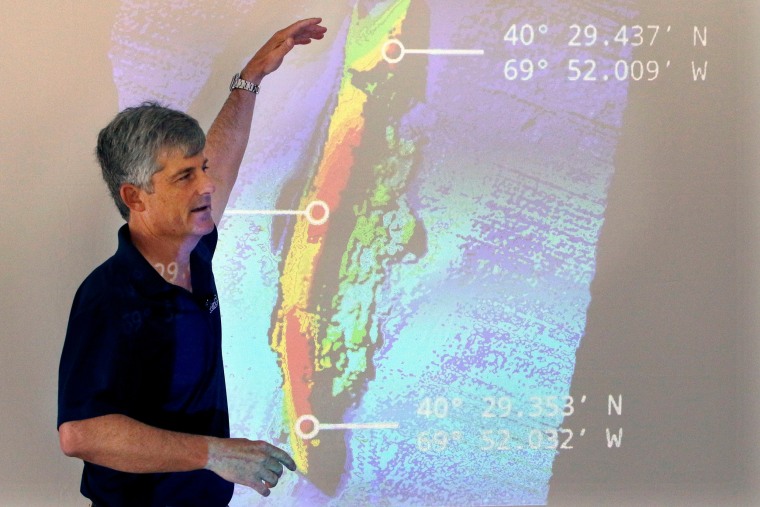
The vessel vanished Sunday during a dive to explore the wreck of the Titanic, part of a tour offering explorers the opportunity to see the site up close for a significant sum . The submersible, called Titan, was on only its third trip since OceanGate Expeditions began offering trips in 2021.
Follow along for live coverage on the missing sub
British adventurer Hamish Harding
British billionaire and adventurer Hamish Harding was among the five people on the vessel.
In a photo captured before Sunday's dive, Harding could be seen looking out from a vessel in a uniform with a badge that says "Titanic expedition crew."
Harding's company, Action Aviation, says on its website that it was established in 2004, operating as a global sales company in business aviation.
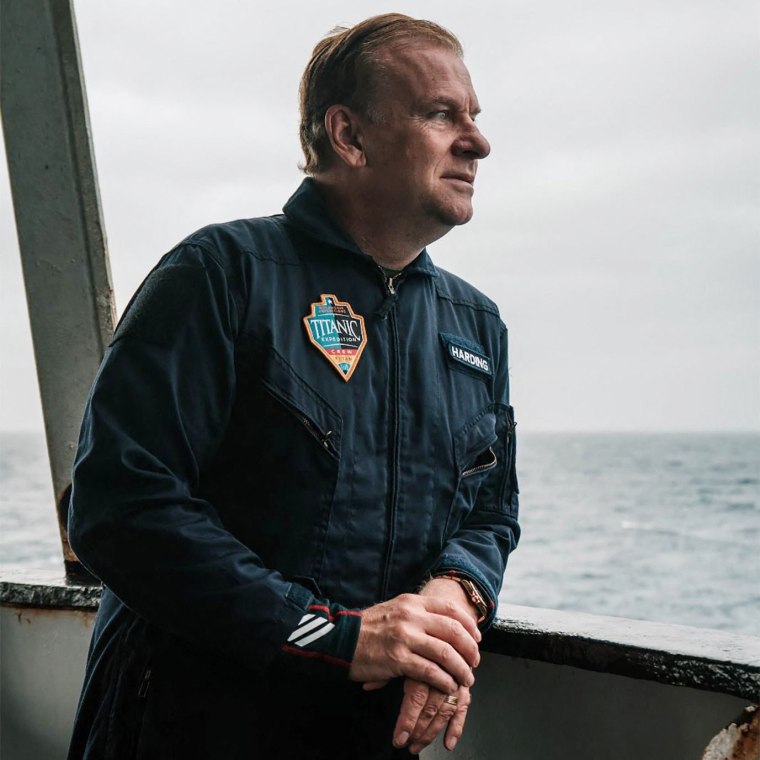
A post Sunday on the billionaire's Instagram account said he was joining OceanGate’s expedition “as a mission specialist” — typically a onetime crew member who pays a fee to join the effort.
“Due to the worst winter in Newfoundland in 40 years, this mission is likely to be the first and only manned mission to the Titanic in 2023,” Harding said in his post. He said that a “weather window” had just opened up and that the team was going to attempt a dive the following day.
“Until then we have a lot of preparations and briefings to do,” he said.
Harding, who lives in Dubai, in the United Arab Emirates, holds three Guinness World Records, including the longest duration at full ocean depth by a crewed vessel. In March 2021, he and ocean explorer Victor Vescovo dived to the lowest depth of the Mariana Trench. In June 2022, he went into space on Blue Origin’s New Shepard rocket, according to The Associated Press.
Pakistani businessman Shahzada Dawood and his son, Suleman
Prominent Pakistani businessman Shahzada Dawood , 48, and his son, Suleman Dawood, 19, were also identified as being on board the vessel by family and by one of Dawood's businesses.
"We are very grateful for the concern being shown by our colleagues and friends and would like to request everyone to pray for their safety while granting the family privacy at this time. The family is well looked after and are praying to Allah for the safe return of their family members," the family said.
"We, at Engro, remain in prayer for their swift and safe return, and will share any updates we may have as and when they come," Engro, the company where Dawood serves as vice chairman of the firm’s board, said.
The father and son, who are both British citizens, belong to one of Pakistan's most prominent families. Their firm invests in agriculture, industries and the health sector, while Shahzada Dawood is also on the board of trustees for the California-based SETI Institute , which searches for extraterrestrial intelligence.
His son, Suleman Dawood, is a college student in the United Kingdom, according to the family's company. Shahzada Dawood is married and has one other child.

OceanGate CEO Stockton Rush
OceanGate CEO Stockton Rush was also on board the vessel, according to a company spokesperson. "OceanGate can confirm that CEO Stockton Rush is aboard the submersible as a member of the crew," the spokesperson said.
Rush oversees the company's "financial and engineering strategies," according to a corporate profile.

Paul Henry Nargeolet
In his Instagram post, Harding wrote that the team on the sub had "a couple of legendary explorers," including "PH Nargeolet."
French diver Paul Henry Nargeolet was on the vessel, his stepson, John Nathaniel Paschall, confirmed Tuesday. Nargeolet's family declined to make any additional statement about the situation.
Nargeolet, who is known by some as "Mr. Titanic," is the director of underwater research at the Experiential Media Group, which creates "museum-quality exhibitions" around the world, according to its website . He is considered a leading authority on the Titanic wreckage, according to a biography on the site.
Nargeolet has led several expeditions to the Titanic wreckage site, completing at least 35 dives in submersibles and supervising the recovery of at least 5,000 artifacts, including the recovery of the “big piece” — a 20-ton section of the Titanic’s hull, according to the biography.
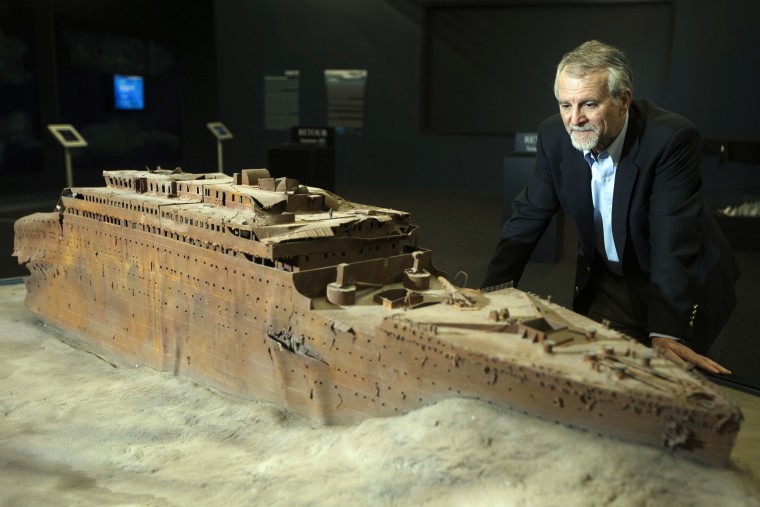
Also known by his first initials, "P.H.," Nargeolet had a 22-year career with the French navy before he retired in 1986 and joined the French Institute for Research and Exploitation of Sea. At the institute, he led the first recovery expedition to the Titanic in 1987, according to the bio.
Years later, in 2010, he "served as the expedition leader on the most technologically advanced dive to Titanic spearheading the first comprehensive survey map of the Ship," according to the bio.
In a 2019 interview with the Irish Examiner , Nargeolet was asked whether he ever got scared of diving to reach the wreck.
“If you are 11m or 11km down, if something bad happens, the result is the same,” he said. “When you’re in very deep water, you’re dead before you realise that something is happening, so it’s just not a problem.”
U.S. Coast Guard officials said they have “brought all assets that we have available” to the search to find the missing sub and its crew.
In a statement, OceanGate Expeditions said its "entire focus is on the crew members in the submersible and their families."
"We are deeply thankful for the extensive assistance we have received from several government agencies and deep sea companies in our efforts to reestablish contact with the submersible,” the company said.
Chantal Da Silva is a breaking news editor for NBC News Digital based in London.
Titanic sub destroyed in 'catastrophic implosion,' all five aboard dead
- Medium Text
SOUNDS FROM THE DEEP
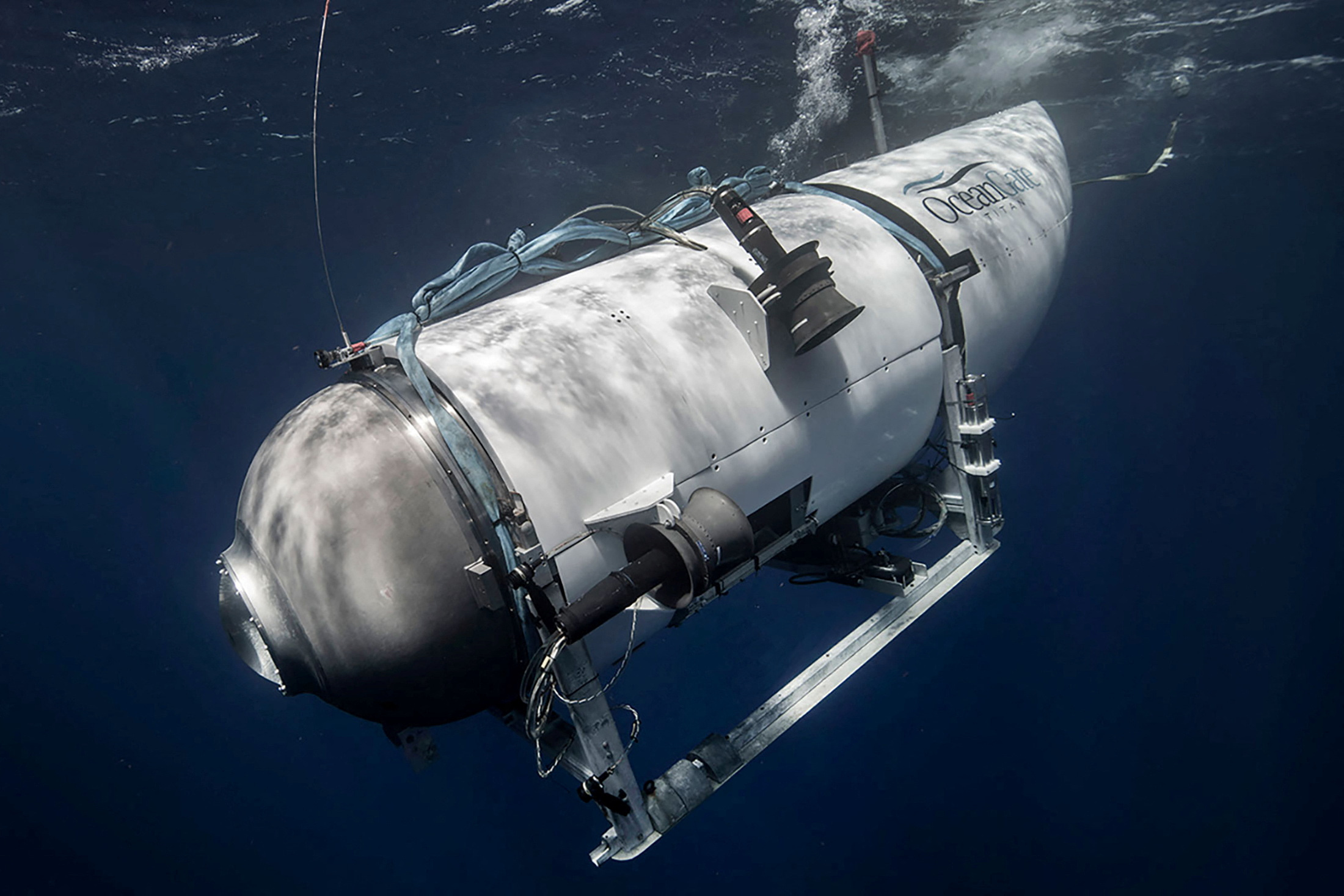
REMOTE-CONTROLLED VEHICLES

Sign up here.
Reporting by Joseph Ax and Steve Gorman; Additional reporting by Rami Ayyub, Tyler Clifford, Richard Lough, Natalie Thomas, Edmund Blair, Ariba Shahid, Shivani Tanna, Caitlin Webber, David Ljunggren, William James, Steve Holland, Daniel Trotta, Brad Brooks, Gabriella Borter, Rollo Ross and Idrees Ali; editing by Grant McCool and Stephen Coates
Our Standards: The Thomson Reuters Trust Principles. New Tab , opens new tab

World Chevron

Russian drones injure 6 in Ukraine's Kharkiv, Dnipro regions
Russia launched an overnight drone attack on Ukraine's Kharkiv and Dnipro regions, injuring at least six people and hitting critical infrastructure, commercial and residential buildings, regional officials said on Saturday.

Stay up to date with notifications from The Independent
Notifications can be managed in browser preferences.
UK Edition Change
- UK Politics
- News Videos
- Paris 2024 Olympics
- Rugby Union
- Sport Videos
- John Rentoul
- Mary Dejevsky
- Andrew Grice
- Sean O’Grady
- Photography
- Theatre & Dance
- Culture Videos
- Food & Drink
- Health & Families
- Royal Family
- Electric Vehicles
- Car Insurance deals
- Lifestyle Videos
- UK Hotel Reviews
- News & Advice
- Simon Calder
- Australia & New Zealand
- South America
- C. America & Caribbean
- Middle East
- Politics Explained
- News Analysis
- Today’s Edition
- Home & Garden
- Broadband deals
- Fashion & Beauty
- Travel & Outdoors
- Sports & Fitness
- Sustainable Living
- Climate Videos
- Solar Panels
- Behind The Headlines
- On The Ground
- Decomplicated
- You Ask The Questions
- Binge Watch
- Travel Smart
- Watch on your TV
- Crosswords & Puzzles
- Most Commented
- Newsletters
- Ask Me Anything
- Virtual Events
- Betting Sites
- Online Casinos
- Wine Offers
Thank you for registering
Please refresh the page or navigate to another page on the site to be automatically logged in Please refresh your browser to be logged in
Five men on missing Titanic sub confirmed dead after debris reveals ‘catastrophic implosion’
Oceangate ceo stockton rush, shahzada dawood and his son suleman dawood, hamish harding, and paul-henri nargeolet ‘have sadly been lost’, article bookmarked.
Find your bookmarks in your Independent Premium section, under my profile

The latest headlines from our reporters across the US sent straight to your inbox each weekday
Your briefing on the latest headlines from across the us, thanks for signing up to the evening headlines email.
The five crew members on board the missing submersible Titan died in a “catastrophic implosion”, the US Coast Guard has confirmed.
Oceangate Expeditions CEO Stockton Rush , Pakistani businessman Shahzada Dawood and his son Suleman, British billionaire Hamish Harding, and French adventurer Paul-Henri Nargeolet were on board the Titan when it lost communications with a support ship less than two hours into a 4,000m dive to the Titanic shipwreck on Sunday.
A remotely operated vehicle (ROV) located pieces of debris from the Titan on the seabed about 500m from the bow of the Titanic wreck on Thursday morning Rear Admiral John Mauger, the First Coast Guard District commander, told a press briefing.
The debris was analysed and confirmed to belong to the Titan, and family members were informed there had been no survivors.
The bodies of the five deceased crew members may never be found, Admiral Mauger added.
“This is an incredibly unforgiving environment down there on the sea floor and the debris is consistent with a catastrophic implosion of the vessel.
- Missing Titanic sub – update: Five men confirmed dead by OceanGate after debris field found
- Watch live: US Coast Guard gives update on missing Titanic submersible after debris found
- Friend of missing Titanic sub passenger tells why he backed out of excursion over safety fears
- Missing Titanic sub rescue teams discover ‘debris field’ in search area
“I can only imagine what this has been like for them and I hope that this discovery provides some solace during this difficult time.”
An OceanGate spokesperson confirmed that the five crew members had “sadly been lost” in a statement to The Independent.
“These men were true explorers who shared a distinct spirit of adventure, and a deep passion for exploring and protecting the world’s oceans.
“Our hearts are with these five souls and every member of their families during this tragic time.”
The Titan submersible vanished 105 minutes after launching from the Polar Prince icebreaker research ship about 900 miles off the coast of Cape Cod on Sunday morning.
The Titan’s twin communication systems — texts and electronic pings — suddenly stopped communicating with the support vessel, and no further sign of life was detected until Thursday’s grim discovery.
A sweeping search effort involving Canadian Boeing P-8 Poseidon and C-130 Hercules reconnaissance aircraft, 10 vessels and underwater sonar buoys had been combing an area of the North Atlantic Ocean twice the size of Connecticut for the past several days.
Slim hopes of finding survivors fell when the US Coast Guard revealed on Thursday morning that a debris field had been found near the Titanic shipwreck by a a remote operated vehicle (ROV) searching for the missing Titan submersible.
The US Coast Guard said it had found five major pieces of debris. The ROV initially found a nose cone, a component found outside the pressure hull.
It then found a “large debris field” where a part of the pressure hull was still intact.
The robotic search crew then found a second debris field where the other end of the pressure hull was located.
When asked whether survivors could have been found if the search and rescue mission reached the stricken sub earlier, Adm Mauger repeated that the vessel had suffered a “catastrophic implosion”.
Sonar devices deployed during the search mission had not picked up any signs of an explosion, Adm Mauger said.
It was too soon to say whether there would be a criminal investigation into the loss of life, he added.
The search teams had been racing to find the Titan before a 96-hour deadline passed on Thursday morning when the vessel’s oxygen reserves were expected to extinguish.
An OceanGate spokesperson told The Independent : “This is an extremely sad time for our dedicated employees who are exhausted and grieving deeply over this loss.
“The entire OceanGate family is deeply grateful for the countless men and women from multiple organizations of the international community who expedited wide-ranging resources and have worked so very hard on this mission.
“We appreciate their commitment to finding these five explorers, and their days and nights of tireless work in support of our crew and their families.
“This is a very sad time for the entire explorer community, and for each of the family members of those lost at sea. We respectfully ask that the privacy of these families be respected during this most painful time.”
Lacking the specialist ROVs necessary to operate at the Titanic shipwreck’s location, officials had to coordinate a multi-national response at breakneck speed involving private companies from at least five countries.
An ROV from the Horizon Arctic, a 307-ft Canadian vessel, located the debris field, the Coast Guard said.
In the days after the vessel disappeared, stories of whistleblower warnings, “experimental” building techniques and faulty communication systems on the OceanGate Expeditions vessel emerged.
Mr Rush, the founder and CEO of OceanGate, had been on many of the Titan’s 13 previous trips to the famed shipwreck and insisted the submersible was safe in interviews.
The Titan had seven onboard mechanisms to resurface in the event of an emergency.
They included thrusters, an inflatable air bladder, and “drop weights” of sandbags and lead pipes that would fall off in the event of an emergency and bring the vessel up to the surface using buoyancy.
If the crew was incapacitated, hooks holding the sandbags were designed to dissolve in sea water, allowing the vessel to rise to the surface.
It’s unclear if any of these safety measures were activated.
Trevor Hale, a spokesman for The Explorers Club, told The Independent that debris discovered on Thursday contained components of the Titan lost on a previous dive.
“We understand debris has been found which may be the landing frame and a rear cover of the tail instrument compartment of the Titan lost on previous dives.
“We hear there may be additional debris but no updated visuals of the submersible.”
Two of the missing crew members, Mr Harding and Mr Nargeolet, are members of The Explorer’s Club.
Join our commenting forum
Join thought-provoking conversations, follow other Independent readers and see their replies
Subscribe to Independent Premium to bookmark this article
Want to bookmark your favourite articles and stories to read or reference later? Start your Independent Premium subscription today.
New to The Independent?
Or if you would prefer:
Want an ad-free experience?
Hi {{indy.fullName}}
- My Independent Premium
- Account details
- Help centre
What we know about the 'catastrophic implosion' that killed five men aboard the Titanic submersible
After several days of searching in a remote area of the North Atlantic, the five people aboard a submersible near the Titanic wreck have been declared dead.
The cause of their deaths was a "catastrophic implosion of the vessel", according to US Coast Guard Rear Admiral John Mauger.
Here's what an implosion means, how it happens and whether the passengers could have felt it.
How was the Titan sub found?
An uncrewed deep-sea robot deployed from a Canadian ship discovered the wreckage of the Titan submersible on Thursday morning.
Soon after the debris of the vessel was found, OceanGate Expeditions, the US-based company that operated the submersible, released a statement confirming the deaths of the five passengers.
"We now believe that our CEO Stockton Rush, Shahzada Dawood and his son Suleman Dawood, Hamish Harding, and Paul-Henri Nargeolet, have sadly been lost," the company said.
What did it find?
Five major fragments of the Titan were located in the debris field left from its disintegration.
This included the vessel's tail cone and two sections of the pressure hull , Coast Guard officials said.
"The debris field here is consistent with a catastrophic implosion of the vehicle," Mauger said.
No mention was made of whether human remains were sighted.
Where was it found?
Wreckage of the Titan submersible was found 488 metres from the bow of the Titanic wreckage.
This was 4 kilometres below the surface.
The US Coast Guard believes the nature and location of the debris suggests a catastrophic implosion which would have killed all five people on board.
When did the sub implode?
The US Coast Guard said it was too soon to say when the implosion happened.
The Titan had been missing since June 18.
He said it was not detected by sonar buoys used by search crews, which suggests it happened before they arrived.
One source says the implosion may have happened days ago.
A US Navy acoustic system detected an "anomaly" on Monday, a senior military official told The Associated Press.
It found the anomaly to be "consistent with an implosion or explosion in the general vicinity of where the Titan submersible was operating when communications were lost".
The official spoke on condition of anonymity to discuss a sensitive acoustic detection system.
The navy passed on the information to the coast guard, which continued its search because the navy did not consider the data to be definitive.
The navy's possible clue was not known publicly until Friday, when The Wall Street Journal first reported it.
What is an implosion?
Implosion is an explosion in reverse , according to Professor Stefano Brizzolara, the co-director of Virginia Tech Center for Marine Autonomy and Robotics.
"Imagine a cylinder: during an explosion, the charge placed in the centre ignites and causes the pressure at the centre to increase instantaneously," Professor Brizzolara told ABC News.
Such intense pressure is what causes the ejection of mass to move from the centre of the cylinder to the outside at an "incredible speed".
"An implosion is the reverse of this," Professor Brizzolara said.
"The inside of the cylinder can practically be considered void, while the pressure of the wave that breaches the hull is 400 times larger.
"This causes a violent flow of water from outside of the cylinder to the inside, with incredible speed.
"We're talking water rushing in at a speed of the order of 1,000 kilometres per hour."
What made it 'catastrophic'?
"Catastrophic implosion" literally means breaking into pieces and small fragments , says Professor Brizzolara.
Here's where "the hull" comes in — it's the main body of a ship or vessel and the Titan's is made from carbon fibre and titanium.
Carbon-reinforced plastic collapses "catastrophically", says Professor Brizzolara.
"This is because the material is not ductile like metal alloys and therefore it 'catastrophically' implodes."
For context, navy submarines use high-strength steel or titanium alloys, Professor Brizzolara says.
"This is why current rules and regulations do not consider composite materials for underwater vehicles meant to operate at large depths," he said.
How did the implosion happen?
A flood or a failure of the pressure vessel would have likely caused the implosion, says submarine expert Eric Fusil from the University of Adelaide.
That kind of "catastrophic event" would have happened within 20 milliseconds , Professor Fusil told ABC News Breakfast this morning.
The Titan's pressure hull was made of a combination of titanium and a composite material of carbon fibres, which he described as "very new".
"The titanium pressure vessel is very elastic — it can crush and then restore its initial shape," Professor Fusil explained.
"But the carbon fibres are completely different — it's something very stiff."
"We have those two opposite forces," he said.
Professor Fusil said it's an "experimental technology" and it was too early to tell whether that design caused the issues.
What does an implosion feel like?
The five passengers inside the Titan submersible might not have realised it was even happening , Professor Fusil says.
"They wouldn't have realised they were dying because they cannot process that information that quickly," he said.
Implosions can be similar to a balloon, says forensic engineer Bart Kemper.
"When I take a needle and poke it into a balloon, once you break that balloon, it's gone," Mr Kemper told 7.30’s Sarah Ferguson.
"That's exactly the problem you have with a pressure vessel, and the fact that this is external pressure, not internal pressure, it doesn't matter.
"Once you lose integrity, with these kinds of pressures, it's gone," he said.
In 2018, submarine experts had warned the company operating the Titan, OceanGate, that without industry oversight the submersible was exposing passengers to possible catastrophic failure.
One of those experts was Mr Kemper.
What about those 'banging noises'?
Underwater sounds described as "banging noises" by a Canadian surveillance vessel initially sparked hope for a possible rescue.
But these underwater sounds heard on Tuesday and Wednesday were probably unrelated to the submersible, The Associated Press reports.
The sounds in the Titan search were picked up using devices called sonobuoys , which can be tossed out of aeroplanes to detect noises, to avoid interference with ship sounds, said Matt Dzieciuch, an ocean acoustics expert at the Scripps Institution of Oceanography.
The ocean is a "noisy place," Dr Dzieciuch said.
There are many other potential sources of sound underwater, including from fish, other animals and of course human-made instruments, he explained.
Search teams heard the banging noises at 30-minute intervals , US Coast Guard Captain Jamie Frederick said at a press conference.
But Mr Frederick went on to say analysis of the noises had been "inconclusive".
"With respect to the noises specifically, we don't know what they are, to be frank with you."
OceanGate has been chronicling the Titanic's decay and the underwater ecosystem around it via yearly voyages since 2021.
The company has not responded to additional questions about the Titan's voyage this week.
The Coast Guard will continue searching for more signs about what happened to the Titan.
- X (formerly Twitter)
- Death and Dying
- Disasters, Accidents and Emergency Incidents
- Engineering
- Oceans and Reefs
- Science and Technology
- Travel and Tourism (Lifestyle and Leisure)
- United States
Missing Titanic tour sub has less than 40 hours of oxygen supply left, US Coast Guard says
The submersible had a 96-hour oxygen supply when it put to sea at roughly 6 a.m. sunday, according to david concannon, an adviser to oceangate., by ben finley and holly ramer • published june 20, 2023 • updated on june 20, 2023 at 6:10 pm.
Rescuers in a remote area of the Atlantic Ocean raced against time early Tuesday to find a missing submersible carrying five people on a mission to document the wreckage of the Titanic, the iconic ocean liner that sank more than a century ago.
The carbon-fiber submersible named the Titan, part of a mission by OceanGate Expeditions, carried a pilot, a renowned British adventurer, two members of an iconic Pakistani business family and the CEO of the company. Authorities reported the vessel overdue Sunday night about 435 miles (700 kilometers) south of St. John’s, Newfoundland, according to Canada's Joint Rescue Coordination Center.
So far, extensive search efforts on the surface and under water have yielded "no results," said Capt. Jamie Frederick, with the First Coast Guard District, in a briefing Tuesday.
Every passing minute, however, puts the Titan's crew at greater risk. The submersible had a 96-hour oxygen supply when it put to sea at roughly 6 a.m. Sunday, according to David Concannon, an adviser to OceanGate. That means oxygen supply could run out Thursday morning.
Get Tri-state area news and weather forecasts to your inbox. Sign up for NBC New York newsletters.
“It is a remote area — and it is a challenge to conduct a search in that remote area,” said Rear Adm. John Mauger, a commander for the U.S. Coast Guard, which also is searching for the Titan. “But we are deploying all available assets to make sure we can locate the craft and rescue the people on board.”
Mauger told NBC’s “TODAY” show on Tuesday that his crews were working to prioritize underwater search efforts and get equipment there that can be helpful to the search.
“We’re working very, very hard to make sure that we bring all assets ... to bring leading technical experts to understand what capability is available, what capability we can get to the team," he said.
U.S. & World

A police officer once rescued an abandoned infant. Two decades later, fate brought them together

Larry Demeritte is just the second Black trainer since 1951 to saddle a horse for the Kentucky Derby
The Canadian research icebreaker Polar Prince, which was supporting the Titan, reportedly lost contact with the vessel about an hour and 45 minutes after it submerged. The Polar Prince was to continue to do surface searches throughout the night and a Canadian Boeing P-8 Poseidon reconnaissance aircraft will resume their surface and subsurface search in the morning, the U.S. Coast Guard said on Twitter. Two U.S. Lockheed C-130 Hercules aircraft also have conducted overflights.
The Canadian military dropped sonar buoys to listen for any possible sounds from the Titan.
Concannon, who said he was supposed to be on the dive but could not go, said officials were also working to get a remotely operated vehicle that can dive to a depth of 3.7 miles (6 kilometers) to the site as soon as possible.
OceanGate’s expeditions to the Titanic wreck site include archaeologists and marine biologists. The company also brings people who pay to come along, known as “mission specialists.” They take turns operating sonar equipment and performing other tasks in the five-person submersible.
The Coast Guard said Monday that there was one pilot and four “mission specialists” aboard. However, OceanGate's website suggests that the fifth person aboard may be a so-called “content expert” who guides the paying customers.
OceanGate said its focus was on those aboard and their families.
“We are deeply thankful for the extensive assistance we have received from several government agencies and deep sea companies in our efforts to reestablish contact with the submersible,” it said in a statement.
WHO ARE THE MISSING TOURISTS ONBOARD THE SUBMERSIBLE?
British businessman Hamish Harding, who lives in Dubai in the United Arab Emirates, was one of the mission specialists, according to Action Aviation, a company for which Harding serves as chairman. The company’s managing director, Mark Butler, told the AP that the crew set out on Friday.
“There is still plenty of time to facilitate a rescue mission, there is equipment on board for survival in this event,” Butler said. “We’re all hoping and praying he comes back safe and sound.”
Harding is a billionaire adventurer who holds three Guinness World Records, including the longest duration at full ocean depth by a crewed vessel. In March 2021, he and ocean explorer Victor Vescovo dived to the lowest depth of the Mariana Trench. In June 2022, he went into space on Blue Origin’s New Shepard rocket.
Harding was “looking forward to conducting research” at the Titanic site, said Richard Garriott de Cayeux, the president of The Explorers Club, a group to which Harding belonged.
"We all join in the fervent hope that the submersible is located as quickly as possible," he said in a statement.
Also on board were Pakistani nationals Shahzada Dawood and his son Suleman, according to a family statement sent to the AP. The Dawoods belong to one of Pakistan's most prominent families. Their eponymous firm invests across the country in agriculture, industries and the health sector.
“We are very grateful for the concern being shown by our colleagues and friends and would like to request everyone to pray for their safety while granting the family privacy at this time,” the statement said. “The family is well looked after and are praying to Allah for the safe return of their family members.”
Shahzada Dawood also is on the board of trustees for the California-based SETI Institute that searches for extraterrestrial intelligence.
Stockton Rush, the CEO of OceanGate Expeditions, is aboard the missing submersible, the company confirmed to NBC News.
French explorer and Titanic expert Paul-Henry Nargeolet also was reportedly on board, according to David Gallo, a senior adviser for strategic initiatives and special projects at RMS Titanic. Gallo identified Nargeolet, a friend who has led multiple expeditions to the Titanic, on Tuesday during an interview with CNN. NBC News has not confirmed the report.
WHAT WE KNOW ABOUT THE OCEANGATE
The expedition was OceanGate’s third annual voyage to chronicle the deterioration of Titanic, which struck an iceberg and sank in 1912, killing all but about 700 of the roughly 2,200 passengers and crew. Since the wreckage’s discovery in 1985, it has been slowly succumbing to metal-eating bacteria. Some have predicted the ship could vanish in a matter of decades as holes yawn in the hull and sections disintegrate.
The initial group of tourists in 2021 paid $100,000 to $150,000 apiece to go on the trip. OceanGate’s website had described the “mission support fee” for the 2023 expedition as $250,000 a person.
Unlike submarines that leave and return to port under their own power, submersibles require a ship to launch and recover them. OceanGate hired the Polar Prince to ferry dozens of people and the submersible craft to the North Atlantic wreck site. The submersible would make multiple dives in one expedition.
The expedition was scheduled to depart from St. John’s, Newfoundland, in early May and finish up at the end of June, according to documents filed by the company in April with a U.S. District Court in Virginia that oversees Titanic matters.
CBS journalist David Pogue, who went on the trip last year, noted his vessel got turned around looking for the Titanic.
“There’s no GPS underwater, so the surface ship is supposed to guide the sub to the shipwreck by sending text messages,” Pogue said in a segment aired on CBS Sunday Morning. “But on this dive, communications somehow broke down. The sub never found the wreck.”
The submersible, named Titan, is capable of diving 2.4 miles (4 kilometers) “with a comfortable safety margin,” OceanGate said in its court filing.
It weighs 20,000 pounds (9,072 kilograms) in the air, but is ballasted to be neutrally buoyant once it reaches the seafloor, the company said.
In a May 2021 court filing, OceanGate said the Titan had an “unparalleled safety feature” that assesses the integrity of the hull throughout every dive.
During its expedition in 2022, OceanGate reported that the submersible had a battery issue on its first dive, and had to be manually attached to its lifting platform, according to a November court filing. More missions, however, followed. OceanGate has described the submersible as a “state-of-the-art vessel” that “is lighter, more spacious and more comfortable than any other deep-diving submersible exploring the ocean today.”
But the custom-built, titanium-domed Titan represented a risk. Pogue and another passenger, a writer and producer for the cartoon series "The Simpsons" named Mike Reiss, noted how the liability waiver for the trip included stark safety warnings. Pogue in his CBS piece also highlighted how much of the “improvised” submersible, about the size of a minivan, operated with a single button, a video game-style controller, a makeshift toilet and material from an RV retailer.
Experts said Monday that rescuers face steep challenges.
Alistair Greig, a professor of marine engineering at University College London, said submersibles typically have a drop weight, which is “a mass they can release in the case of an emergency to bring them up to the surface using buoyancy.”
“If there was a power failure and/or communication failure, this might have happened, and the submersible would then be bobbing about on the surface waiting to be found,” Greig said.
Another scenario is a leak in the pressure hull, in which case the prognosis is not good, he said.
“If it has gone down to the seabed and can’t get back up under its own power, options are very limited," Greig said. “While the submersible might still be intact, if it is beyond the continental shelf, there are very few vessels that can get that deep, and certainly not divers.”
Even if they could go that deep, he doubts they could attach to the hatch of OceanGate's submersible.
By Tuesday morning, an area totaling 10,000 square miles had been searched, the U.S. Coast Guard tweeted.
Associated Press writers Danica Kirka, Jill Lawless and Sylvia Hui in London, Robert Gillies in Toronto, Olga R. Rodriguez in San Francisco, Jon Gambrell in Dubai, United Arab Emirates, and Munir Ahmed in Islamabad contributed to this report.
This article tagged under:
Watch CBS News
What we know about the tourist sub that disappeared on an expedition to the Titanic
By Emily Mae Czachor
Updated on: June 23, 2023 / 11:35 PM EDT / CBS News
Five people on board the tourist submarine that disappeared on an expedition to explore the Titanic shipwreck over the weekend did not survive a "catastrophic loss of the pressure chamber," officials said Thursday.
The announcement came after the U.S. Coast Guard said the massive search underway in the North Atlantic had located a debris field on the sea floor, which was confirmed to be pieces of the missing sub .
"The debris field is consistent with a catastrophic implosion of the vessel," Rear Adm. John Mauger of the Coast Guard said at a briefing, offering "deepest condolences to the families." A spokesperson for OceanGate Expeditions, the company behind the voyage, told reporters that the passengers, including OceanGate CEO Stockton Rush, "have sadly been lost."
Here's what we know so far about the submersible craft and what led up to this point.
What happened?
A five-person crew on a submersible named Titan, owned by OceanGate Expeditions, submerged on a dive to the Titanic wreckage site Sunday morning, and the crew of the Polar Prince research ship lost contact with the sub about an hour and 45 minutes later, the Coast Guard said .
The Coast Guard first alerted mariners about the missing sub Sunday night, saying a "21 foot submarine" with a white hull was overdue and giving its last known position. "VESSELS IN VICINITY REQUESTED TO KEEP A SHARP LOOKOUT, ASSIST IF POSSIBLE," the alert message read.
The sub was lost in an area about 900 miles east of Cape Cod, in the North Atlantic, in water with a depth of about 13,000 feet, which is about level with the depth of the Titanic wreck . Amid growing concern about its dwindling supply of breathable air , search and rescue efforts by a unified command composed of several international agencies ramped up accordingly.
The five people aboard included an operator — later identified as Stockton Rush, the CEO of OceanGate Expeditions — and four mission specialists, a term the company uses for its passengers, who paid up to $250,000 for a seat.
For days, the fate of the sub and its passengers was a mystery.
But after the debris was found, a U.S. Navy official said the Navy had detected "an acoustic anomaly consistent with an implosion" shortly after the sub lost contact with the surface Sunday, CBS News national security correspondent David Martin reported. The information was relayed to the Coast Guard, which used it to narrow the radius of the search area, the official said.
Such an implosion, under the intense pressure of the depths of the sea , would have destroyed the vessel almost instantly, experts explained.
"in a fraction of a second, it's gone," Will Kohnen, chairman of the professional group the Marine Technology Society Submarine Committee, told the Reuters news agency.
"It implodes inwards in a matter of a thousandth of a second," Kohnen said. "And it's probably a mercy, because that was probably a kinder end than the unbelievably difficult situation of being four days in a cold, dark and confined space. So, this would have happened very quickly. I don't think anybody even had the time to realize what happened."
The Coast Guard is leading the investigation into the incident, and the National Transportation Safety Board said Friday it will assist.
Who were the passengers aboard the sub?
CBS News confirmed that the five people aboard the submersible were Hamish Harding , a 59-year-old British billionaire, business owner and explorer; British-Pakistani businessman Shahzada Dawood and his son, Suleman; French explorer Paul-Henri Nargeolet, who had made multiple dives over the years to explore the Titanic; and Stockton Rush, the CEO of OceanGate Expeditions, who was serving as pilot.
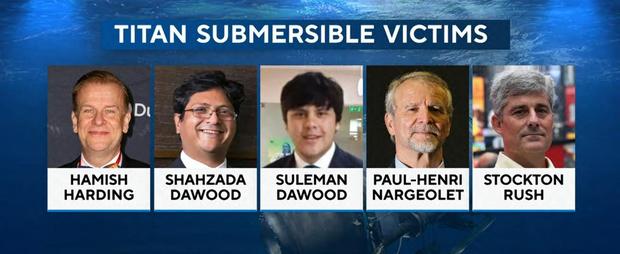
Just ahead of the Coast Guard briefing Thursday afternoon, a statement issued by OceanGate spokesperson Andrew Von Kerens offered condolences to the families of the Titan crew and recognized that all five people on board the submersible were believed to be dead.
"These men were true explorers who shared a distinct spirit of adventure, and a deep passion for exploring and protecting the world's oceans," the company said in the statement. "Our hearts are with these five souls and every member of their families during this tragic time. We grieve the loss of life and joy they brought to everyone they knew."
When the Coast Guard confirmed the sub's likely implosion on Thursday, Mauger said they were communicating with consulates general in both the U.K. and France.
The Dawood family, of the large Pakistan-based global business conglomerate Dawood Group, issued a statement Tuesday confirming their family members were on the expedition.
"Please continue to keep the departed souls and our family in your prayers during this difficult time of mourning," the Hussain and Kulsum Dawood family said Thursday in a statement through the Dawood Foundation. "We are truly grateful to all those involved in the rescue operations. ... The immense love and support we receive continues to help us endure this unimaginable loss."
Nargeolet, a renowned French explorer and former diver for the French Navy who was part of the first expedition to visit the Titanic wreck in 1987, was returning for another dive aboard the Titan submersible.
In a Facebook post on Monday, Rory Golden, an explorer who became the first Irish diver to visit the Titanic wreckage in 2000, said he was part of the voyage but was not on the submersible that went missing.
Search and rescue efforts
Authorities said early Thursday morning that a Canadian vessel, Horizon Arctic, had deployed a remotely operated underwater vehicle that reached the sea floor . The ROV ultimately located what the Coast Guard originally described as a debris field on the sea floor, which included identifiable pieces of the sub, authorities confirmed that afternoon.
"This morning, an ROV, or remote operated vehicle, from the vessel Horizon Arctic, discovered the tail cone of the Titan submersible approximately 1,600 feet from the bow of the Titanic on the sea floor," said Mauger at a news briefing. "The ROV subsequently found additional debris. In consultation with experts from within the unified command, the debris is consistent with the catastrophic loss of the pressure chamber."
"Upon this determination, we immediately notified the families," he added. "On behalf of the United States Coast Guard and the entire unified command, I offer my deepest condolences to the families. I can only imagine what this has been like for them and I hope that this discovery provides some solace during this difficult time."
Mauger said authorities were "still working to develop the details for the timeline involved with this casualty and the response," and referenced the "incredibly complex operating environment along the sea floor, over two miles beneath the surface."
Paul Hankins, an undersea expert for the U.S. Navy, explained during the news conference that crews discovered "five different major pieces of debris that told us that it was the remains of the Titan." These pieces included, initially, the nose cone, which was outside of the pressure hull.
"We then found a large debris field," Hankins said. "Within that large debris field, we found the front end bell of the pressure hull. That was our first indication that there was a catastrophic event."
A second, smaller debris field was located shortly after, and the debris found there "comprised the totality of that pressure vessel," Hankins said.
"The debris field is consistent with a catastrophic implosion of the vessel," he said, adding that the team will continue to map the debris field area.
Asked by a reporter what the prospects were for recovering the passengers, Mauger said, "This is an incredibly unforgiving environment down there on the sea floor, and the debris is consistent with a catastrophic implosion of the vessel. So we'll continue to work and continue to search the area down there, but I don't have an answer for prospects at this time."
Discovering the Titan debris came after multiple agencies from the U.S. and Canada spent days scouring thousands of square miles of open ocean in search of the missing sub.
The U.S. Coast Guard announced Wednesday that underwater noises were detected in the search area and that searches involving ROVs were focusing on the area where the noises were heard .
On Wednesday, three more vessels had arrived to join the search, including one with side-scan sonar capabilities designed to create images of large sections of the sea floor, the Coast Guard said in a tweet . That vessel began conducting search patterns alongside at least two others, as multiple military and other agencies worked together under a unified command.
Frederick said Wednesday there were five "surface assets" involved in the search , and another five were expected to join the operation within the next 24 to 48 hours. He said the team also had two ROVs "actively searching," with several more due to arrive to join the search Thursday.
The Coast Guard said it had C-130 aircraft searching for the sub, and that the Rescue Coordination Center Halifax was assisting with a P-8 Poseidon aircraft, which has underwater detection capabilities. Canadian P-3s were also involved in the operation and deployed sonar buoys.
Just after midnight Wednesday, officials said aircraft had detected underwater noises in the search area, and underwater search operations were relocated as a result, though the origin of the noises remained unknown. The sounds were picked up several times Tuesday night and Wednesday morning, according to the Coast Guard.
"With respect to the noises, specifically, we don't know what they are, to be frank with you," Frederick said. "The P-3 detected noises, that's why they're up there, that's why they're doing what they're doing, that's why there are sonar buoys in the water."
News of the vanished submersible and subsequent rescue mission originally broke Monday morning. At the time, Lt. Jordan Hart of the Coast Guard in Boston told CBS News that personnel there were leading the rescue mission, and focusing on waters off Newfoundland in eastern Canada.
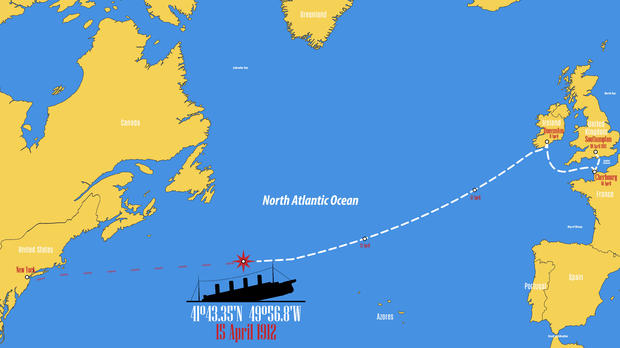
The Boston Regional Coordination Center was managing the rescue operation, as the location of the Titanic shipwreck falls within the Boston coordination center's territory, according to a map of jurisdictions along the East Coast of North America.
That combined search area grew to about twice the size of the state of Connecticut, and the subsurface search extended down as far as 2 and a half miles deep, Frederick said, stressing that the search and rescue teams were dealing with an incredibly complex set of circumstances.
"We also have to factor in the ever-changing weather conditions, currents and sea states that expand the search area every hour," he said earlier in the week. "There's an enormous complexity associated with this case due to the location being so far offshore and the coordination between multiple agencies and nations. We greatly appreciate the outpouring of support and offers to provide additional equipment."
What caused the noises?
Frederick acknowledged that the sounds detected underwater by Canadian aircraft could have been caused by multiple sources.
Following the discovery of the sub debris on the sea floor, a U.S. Navy source told CBS News that the implosion would be inconsistent with banging noises heard at 30-minute intervals. Those noises, the official said, are now assessed as having come from other ships in the area.
Carl Hartsfield, an expert in underwater acoustics and the director of the Woods Hole Oceanographic Institution, which is on-site at the search area as a consultant, explained that it can be challenging to differentiate between "human sounds" and "nature sounds" coming from beneath the surface.
"The ocean is a very complex place, obviously, human sounds, nature sounds, and it's very difficult to discern what the sources of those noises are at times," Hartsfield said.
Before the sub was found, Chris Roman, an associate professor of oceanography at the University of Rhode Island, told CBS News that, technically, it was possible that sounds from inside a submersible could have been detected, but that wasn't the only potential source of the noise.
"Sound travels very efficiently underwater. If people were intentionally making noises within the sub, it's very likely they could be detected with a sound buoy, and that position can be translated into a new search area," Roman said. But he also noted that, as Frederick mentioned in his briefing, "there's a lot of other things in the ocean that make noises."
The submarine
The unique submersible craft that disappeared was owned by OceanGate Expeditions , a company that deploys manned submarines for deep sea exploration and has in the past advertised this particular sub's voyages to carry tourists down to the wreckage of the RMS Titanic for $250,000 per seat.
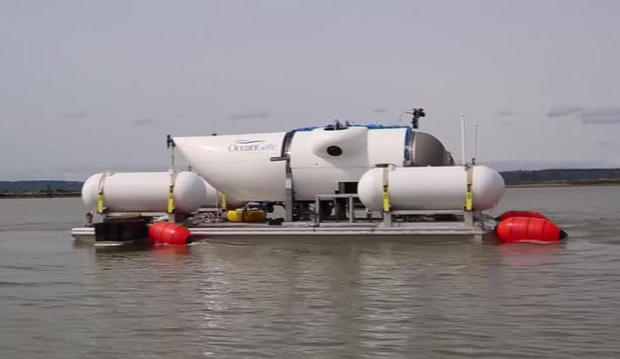
More than a century after the Titanic sank in April 1912, the wreck lies on the ocean floor about 400 miles southeast of the Newfoundland coast.
OceanGate said recently on its website and on social media that its expedition to the shipwreck was "underway," describing the seven-night trip as a "chance to step outside of everyday life and discover something truly extraordinary." In addition to one ongoing expedition, the company had planned two others for the summer of next year, according to the site.
Because of the sub's oxygen capacity, it can only be fully submerged for a portion of the weeklong voyage. The sub has emergency oxygen and a 96-hour sustainment capability if there's an emergency aboard, Mauger said.
In a statement Monday after news broke of the missing sub, OceanGate confirmed the missing submersible was theirs and that a rescue operation had been launched to find and recover it. The company said it was "exploring and mobilizing all options to bring the crew back safely."
"For some time, we have been unable to establish communications with one of our submersible exploration vehicles which is currently visiting the wreck site of the Titanic," said Andrew Von Kerens, a spokesperson for OceanGate. "We pray for the safe return of the crew and passengers, and we will provide updates as they are available."
Inside the Titan
Dubbed the Titan, OceanGate's deep sea vessel, was said to be the only five-person submersible in the world with the capabilities to reach the Titanic's depth, nearly 2 and a half miles beneath the ocean's surface, CBS "Sunday Mornings" correspondent David Pogue reported last year.
BBC News reported that the vessel typically carries a pilot, three paying guests and another person described as a "content expert" by the company. OceanGate's site says the Titan, weighing around 23,000 pounds, has the ability to reach depths of up to 4,000 meters — over 13,000 feet — and has about 96 hours of life support for a crew of five people.
Last summer, Pogue accompanied the Titan crew on the journey from Newfoundland to the site where the Titanic as lost. Several dive attempts had to be canceled when weather conditions indicated it may not be safe. At the time, he described the Titan as a one-of-a-kind submersible craft made from thick carbon fiber and coated on both ends by a dome of titanium.
In 2018, a former employee of OceanGate Expeditions, submersible pilot David Lochridge, voiced concerns about the safety of the Titanic tour sub and filed a lawsuit against the company .
Lochridge, who was fired by OceanGate and sued by the company for allegedly disclosing confidential information in a whistleblower complaint to the Occupational Safety and Health Administration, said in a court filing that the Titan would carry passengers as deep as 4,000 meters even though that depth had never been reached in a sub with its type of carbon fiber hull. According to his claim, he learned the vessel was built to withstand a certified pressure of 1,300 meters, although OceanGate planned to take passengers to 4,000 meters.
Lochridge was not the only skeptic. The same year his complaint was filed, other industry leaders approached OceanGate with questions about the safety of its submersible. William Kohnen, president and CEO of Hydrospace Group, outlined his concerns in a 2018 letter to OceanGate, originally published by The New York Times, that warned of potentially "catastrophic" issues with the "experimental" sub, which was not certified. Kohnen told CBS News on Wednesday that although he did not send it, the letter was leaked to OceanGate and prompted the company to "amend a number of details that made sure the public knew" the submersible had not received its certification.
"The letter to Oceangate was meant as a professional courtesy to the CEO expressing industry concerns that the company was not following a traditional classification route for the certification of the submersible," Kohnen said. "The industry operates along an established and dynamic set of safety regulations and protocols that have served the submersible industry worldwide."
Ahead of his planned dive last summer, Pogue recalled signing paperwork that read, in part, "This experimental vessel has not been approved or certified by any regulatory body, and could result in physical injury, emotional trauma, or death."
Space inside the submarine was similar to the interior of a minivan, and, with just one button and a video game controller used to steer it, the vessel "seemed improvised, with off-the-shelf components," Pogue said.
On his voyage, the sub was lost for a few hours , Pogue said.
"There's no GPS underwater, so the surface ship is supposed to guide the sub to the shipwreck by sending text messages," he reported at the time. "But on this dive, communications somehow broke down."
You may remember that the @OceanGateExped sub to the #Titanic got lost for a few hours LAST summer, too, when I was aboard…Here’s the relevant part of that story. https://t.co/7FhcMs0oeH pic.twitter.com/ClaNg5nzj8 — David Pogue (@Pogue) June 19, 2023
Were conditions right for the dive?
G. Michael Harris, founder of RMS Titanic, Inc. — a company that salvages artifacts from the Titanic wreckage — told CBS News on Tuesday evening that Titanic expeditions are generally conducted within a "three-month weather window" between the end of June and September, when the ocean waters are at their calmest.
Harris, who has led several expeditions to the wreckage site, questioned why the Titan's dive was conducted as early as Sunday.
"Right now, it's really early in the season. I'm not sure why OceanGate went out this soon," Harris said.
Harris also noted that when he conducts diving expeditions, he uses a transponder system, something that he believed the Titan likely did not have.
"It's a net that we navigate in so that we know where we are at all times on the wreck of the Titanic," Harris said. "We're in constant communication with the vessel up top."
Harris said the Titan was "put on a sled and dumped in the water and their only navigation is from the support ship up top."
"I don't adhere to that myself, personally," Harris said.
Harris noted that he has worked with Nargeolet, who is listed as director of underwater research for RMS Titanic, for the past 30 years, describing him as an "all-around good guy."
Who was Hamish Harding?
Harding, the first of the passengers to be publicly identified, had previously posted on social media about joining the Titanic shipwreck expedition.
In a post shared to his Facebook page on Saturday, Harding wrote: "I am proud to finally announce that I joined OceanGate Expeditions for their RMS TITANIC Mission as a mission specialist on the sub going down to the Titanic."
I am proud to finally announce that I joined OceanGate Expeditions for their RMS TITANIC Mission as a mission specialist... Posted by Hamish Harding on Saturday, June 17, 2023
"Due to the worst winter in Newfoundland in 40 years, this mission is likely to be the first and only manned mission to the Titanic in 2023," Harding's Facebook post continued. "A weather window has just opened up and we are going to attempt a dive tomorrow. We started steaming from St. Johns, Newfoundland, Canada yesterday and are planning to start dive operations around 4am tomorrow morning. Until then we have a lot of preparations and briefings to do."
That post was Harding's most recent social media update related to the submarine trip. It included multiple photographs of him, including one that showed Harding signing his name on a banner that read "Titanic Expedition Mission V" and another that pictured the submersible vessel itself.
Richard Garriott de Cayeux, president of The Explorers Club, where Harding helped found the board of trustees, said they had spoken just a week earlier about the expedition.
"When I saw Hamish last week at the Global Exploration Summit, his excitement about this expedition was palpable. I know he was looking forward to conducting research at the site," he said in a letter to club members after the sub's disappearance.
Harding was a veteran adventure tourist who also traveled to space aboard a Blue Origin rocket last year. Two years ago, he made it to the deepest part of the ocean, traveling with U.S. explorer Victor Vescovo to the floor of the Mariana Trench, 35,876 feet below the sea surface. That trip, in a $48 million submersible, earned both explorers the Guinness World Record for the longest distance traveled at the deepest part of the ocean by a crewed vessel.
"It was potentially scary, but I was so busy doing so many things — navigating and triangulating my position — that I did not really have time to be scared," Harding told The Week after that excursion.
This is an updated version of an article originally published on Monday, June 19. Reporting contributed by Emmet Lyons, Roxana Saberi, Alex Sundby, Aimee Picchi, Aliza Chasan, Li Cohen, Caroline Hinson, Anna Noryskiewicz, Analisa Novak and other CBS News staff.
- Newfoundland
- United States Coast Guard
Emily Mae Czachor is a reporter and news editor at CBSNews.com. She covers breaking news, often focusing on crime and extreme weather. Emily Mae has previously written for outlets including the Los Angeles Times, BuzzFeed and Newsweek.
More from CBS News
- Share full article
Advertisement
OceanGate Was Warned of Potential for ‘Catastrophic’ Problems With Titanic Mission
Experts inside and outside the company warned of potential dangers and urged the company to undergo a certification process.

By Nicholas Bogel-Burroughs , Jenny Gross and Anna Betts
- June 20, 2023
Years before OceanGate’s submersible craft went missing in the Atlantic Ocean with five people onboard, the company faced several warnings as it prepared for its hallmark mission of taking wealthy passengers to tour the Titanic’s wreckage.
It was January 2018, and the company’s engineering team was about to hand over the craft — named Titan — to a new crew who would be responsible for ensuring the safety of its future passengers. But experts inside and outside the company were beginning to sound alarms.
OceanGate’s director of marine operations, David Lochridge, started working on a report around that time, according to court documents, ultimately producing a scathing document in which he said the craft needed more testing and stressed “the potential dangers to passengers of the Titan as the submersible reached extreme depths.”
Two months later, OceanGate faced similarly dire calls from more than three dozen people — industry leaders, deep-sea explorers and oceanographers — who warned in a letter to its chief executive, Stockton Rush, that the company’s “experimental” approach and its decision to forgo a traditional assessment could lead to potentially “catastrophic” problems with the Titanic mission.
Now, as the international search for the craft enters another day, more is coming to light about the warnings leveled at OceanGate as the company raced to provide extreme tourism for the wealthy.
A spokesman for OceanGate declined to comment on the five-year-old critiques from Mr. Lochridge and the industry leaders. Nor did Mr. Lochridge respond to a request for comment.
Mr. Rush, the company’s chief executive, is one of the passengers on the vessel and was serving as its pilot when it went missing on Sunday, the company said on Tuesday.
An aerospace engineer and pilot, he founded the company, based in Everett, Wash., in 2009. For the past three years, he has charged up to $250,000 per person for a chance to visit the wreckage of the Titanic, which sank in 1912 on its inaugural trip from England to New York.
The critiques from Mr. Lochridge and the experts who signed the 2018 letter to Mr. Rush were focused in part on what they characterized as Mr. Rush’s refusal to have the Titan inspected and certified by one of the leading agencies that do such work.
Mr. Lochridge reported in court records that he had urged the company to do so, but that he had been told that OceanGate was “unwilling to pay” for such an assessment. After getting Mr. Lochridge’s report, the company’s leaders held a tense meeting to discuss the situation, according to court documents filed by both sides. The documents came in a lawsuit that OceanGate filed against Mr. Lochridge in 2018, accusing him of sharing confidential information outside the company.
In the documents, Mr. Lochridge reported learning that the viewport that lets passengers see outside the craft was only certified to work in depths of up to 1,300 meters.
That is far less than would be necessary for trips to the Titanic, which is nearly 4,000 meters below the ocean’s surface.
“The paying passengers would not be aware, and would not be informed, of this experimental design,” lawyers for Mr. Lochridge wrote in a court filing.
The meeting led OceanGate to fire Mr. Lochridge, according to court documents filed by both sides. OceanGate has said in court records that he was not an engineer, that he refused to accept information from the company’s engineering team and that acoustic monitoring of the hull’s strength was better than the kind of testing that Mr. Lochridge felt was necessary.
The company said in its lawsuit that it appeared Mr. Lochridge was trying to be fired. Mr. Lochridge responded by alleging wrongful termination. The legal battle ended in a settlement later in 2018.
The separate warning that OceanGate received that same year came from 38 experts in the submersible craft industry; all of them were members of the Manned Underwater Vehicles committee of the Marine Technology Society, a 60-year-old industry group that promotes, studies and teaches the public about ocean technology. The experts wrote in their letter to Mr. Rush that they had “unanimous concern” about the way the Titan had been developed, and about the planned missions to the Titanic wreckage.
The letter said that OceanGate’s marketing of the Titan had been “at minimum, misleading” because it claimed that the submersible would meet or exceed the safety standards of a risk assessment company known as DNV, even though the company had no plans to have the craft formally certified by the agency.
“Their plan of not following classification guidelines was considered very risky,” Will Kohnen, the chairman of the committee, said in an interview on Tuesday.
The industry leaders said in their letter that OceanGate should, at minimum, test its prototypes under the watch of DNV or another leading certification company.
“While this may demand additional time and expense,” the signatories wrote, “it is our unanimous view that this validation process by a third-party is a critical component in the safeguards that protect all submersible occupants.”
Mr. Kohnen said that Mr. Rush called him after reading the letter and told him that industry standards were stifling innovation.
In an unsigned 2019 blog post titled “Why Isn’t Titan Classed?,” the company made similar arguments. OceanGate said in the post that because its Titan craft was so innovative, it could take years to get it certified by the usual assessment agencies. “Bringing an outside entity up to speed on every innovation before it is put into real-world testing is anathema to rapid innovation,” the company wrote.
Another signatory of the 2018 letter, Bart Kemper, said in an interview that OceanGate had avoided having to abide by certain U.S. regulations by deploying the vessel in international waters, where Coast Guard rules did not apply.
“This letter was basically asking them to please do what the other submarines do, especially the passenger ones,” said Mr. Kemper, a forensic engineer who works on submarine designs.
Submersibles, unlike boats and other vessels, are largely unregulated, particularly when they operate in international waters, said Salvatore Mercogliano, an associate professor of maritime history at Campbell University in North Carolina.
Because the Titan is loaded onto a Canadian ship and then dropped into the North Atlantic near the Titanic, he said, it does not need to register with a country, fly a flag or follow rules that apply to many other vessels.
“It’s kind of like a boat on the back of a trailer,” Mr. Mercogliano said. “The police will ensure the trailer meets the requirements to be on the road, but they really won’t do a boat inspection.”
The Passenger Vessel Safety Act of 1993, which regulates submersibles that carry passengers and requires that they be registered with the Coast Guard, does not apply to the Titan because it does not fly an American flag or operate in American waters, he said.
Mr. Rush has spoken publicly in the past about what he viewed as regulatory red tape in the industry.
“There hasn’t been an injury in the commercial sub industry in over 35 years,” he told Smithsonian magazine in a profile published in 2019 . “It’s obscenely safe because they have all these regulations. But it also hasn’t innovated or grown — because they have all these regulations.”
In a CBS report last year, David Pogue, a former New York Times technology columnist, joined one of OceanGate’s Titanic expeditions and said the paperwork that he signed before getting onboard warned that the Titan was an “experimental vessel” that had not been “approved or certified by any regulatory body, and could result in physical injury, emotional trauma or death.”
OceanGate has made two previous expeditions to the Titanic site, in 2021 and 2022, and said in a May blog post that it “always expects new challenges” with each trip. “We’re starting our Titanic Expedition earlier than usual and have been tracking all the social media posts showing icebergs and sea ice in the area,” the post read.
The earlier trips, while largely successful, were not without problems.
In February, a couple in Florida sued Mr. Rush, saying that his company refused to refund them the $105,000 that they each paid to visit the Titanic on the Titan in 2018. The trip was postponed several times, according to the suit, in part because the company said it needed to run more tests on the Titan. The couple claimed that Mr. Rush reneged on his promise of giving them a refund and that the company instead demanded that they participate in a July 2021 voyage to the wreckage.
The lawsuit is pending and Mr. Rush has not responded to it. Court records do not list a lawyer representing him in that case.
In a court filing last year, OceanGate referenced some technical issues with the Titan during the 2021 trip.
“On the first dive to the Titanic, the submersible encountered a battery issue and had to be manually attached to its lifting platform,” the company’s legal and operational adviser, David Concannon, wrote in the document, which was filed in the U.S. District Court for the Eastern District of Virginia, which oversees matters having to do with the Titanic. The submersible sustained modest damage to its exterior, he wrote, leading OceanGate to cancel the mission so it could make repairs.
Still, Mr. Concannon wrote in the filing, 28 people were able to visit the Titanic wreckage on the Titan last year.
Mr. Concannon invited the federal judge who was hearing the case, Rebecca Beach Smith, to join the company for an expedition, according to a separate filing, something the judge seemed interested in doing.
“Perhaps, if another expedition occurs in the future, I will be able to do so,” the judge wrote in May, adding that after many years of hearing cases about the Titanic wreckage, “that opportunity would be quite informative and present a first ‘eyes on’ view of the wreck site by the court.”
Kitty Bennett and Susan C. Beachy contributed research. Mike Baker and Shawn Hubler contributed reporting.
Nicholas Bogel-Burroughs reports on national news. He is from upstate New York and previously reported in Baltimore, Albany, and Isla Vista, Calif. More about Nicholas Bogel-Burroughs
Jenny Gross is a general assignment reporter. Before joining The Times, she covered British politics for The Wall Street Journal. More about Jenny Gross
Anna Betts is a reporter for the National desk and a member of the 2023-2024 New York Times Fellowship class. More about Anna Betts

IMAGES
VIDEO
COMMENTS
June 22, 2023 Updated 5:17 PM PT. NEW YORK —. All five passengers aboard a submersible that vanished while on a dive to explore the Titanic wreck site have died, officials said Thursday after ...
It's unclear where or how deep the Titan was when the implosion occurred, but the Titanic wreck sits nearly 13,000 feet (or almost 4,000 meters) below sea level. The submersible was about 1 hour ...
The debris was found off the bow of the sunken Titanic, officials said. The search for the Titan, which went missing Sunday after it e mbark ed on a mission to survey the wreckage of the Titanic ...
0:00. 1:47. Five men, including one teenager, have been declared dead days after they left for a voyage in a 22-foot submersible to see the wreckage of the Titanic in the North Atlantic Ocean ...
The Titan submersible bound for the Titanic that went missing on Sunday with five people on board suffered a "catastrophic implosion," US Coast Guard Rear Adm. John Mauger said Thursday. Now ...
What we know about the 5 men who were aboard the wrecked Titan sub. The five men who were aboard the Titan were declared dead on Thursday after search and rescue crews found evidence the ...
Pieces of the missing Titan vessel were found on the ocean floor, about 1,600 feet from the bow of the Titanic, the Coast Guard said. OceanGate Expeditions, the vessel's operator, said, "Our ...
June 22, 2023. A vast multinational search for five people who had descended to view the wreckage of the sunken R.M.S. Titanic ended on Thursday after pieces of the privately owned submersible ...
OceanGate, the tour company, has said all 5 passengers are believed dead. The Titan: The voyage to see the Titanic wreckage is eight days long, costs $250,000 and is open to passengers age 17 and ...
The vessel vanished Sunday during a dive to explore the wreck of the Titanic, part of a tour offering explorers the opportunity to see the site up close for a significant sum. The submersible ...
By Emma Bubola , Salman Masood and Victoria Kim. June 23, 2023. Five people were on board the Titan submersible when it lost contact with its support ship during a dive to the Titanic wreckage ...
The RMS Titanic, which struck an iceberg and sank during its maiden voyage in 1912, killing more than 1,500 people aboard, lies about 900 miles (1,450 km) east of Cape Cod, Massachusetts, and 400 ...
Five men on missing Titanic sub confirmed dead after debris reveals 'catastrophic implosion' OceanGate CEO Stockton Rush, Shahzada Dawood and his son Suleman Dawood, Hamish Harding, and Paul ...
Tributes from grief-stricken relatives and friends have been pouring in after a "catastrophic implosion" killed all five passengers on board a Titanic-bound submersible at the bottom of the ocean.
Wreckage of the Titan submersible was found 488 metres from the bow of the Titanic wreckage. This was 4 kilometres below the surface. A deep-sea robot operating remotely discovered debris from the ...
Missing Titanic tour sub has less than 40 hours of oxygen supply left, US Coast Guard says The submersible had a 96-hour oxygen supply when it put to sea at roughly 6 a.m. Sunday, according to ...
In 2018, a former employee of OceanGate Expeditions, submersible pilot David Lochridge, voiced concerns about the safety of the Titanic tour sub and filed a lawsuit against the company.
On 18 June 2023, Titan, a submersible operated by the American tourism and expeditions company OceanGate, imploded during an expedition to view the wreck of the Titanic in the North Atlantic Ocean off the coast of Newfoundland, Canada.Aboard the submersible were: Stockton Rush, the American chief executive officer of OceanGate; Paul-Henri Nargeolet, a French deep-sea explorer and Titanic ...
Tour themes include "From Death Do Us Part," which relates love stories among the permanent residents, and "Unsinkable to Unthinkable," which focuses on the Titanic passengers buried at ...
By Nicholas Bogel-Burroughs , Jenny Gross and Anna Betts. June 20, 2023. Years before OceanGate's submersible craft went missing in the Atlantic Ocean with five people onboard, the company faced ...